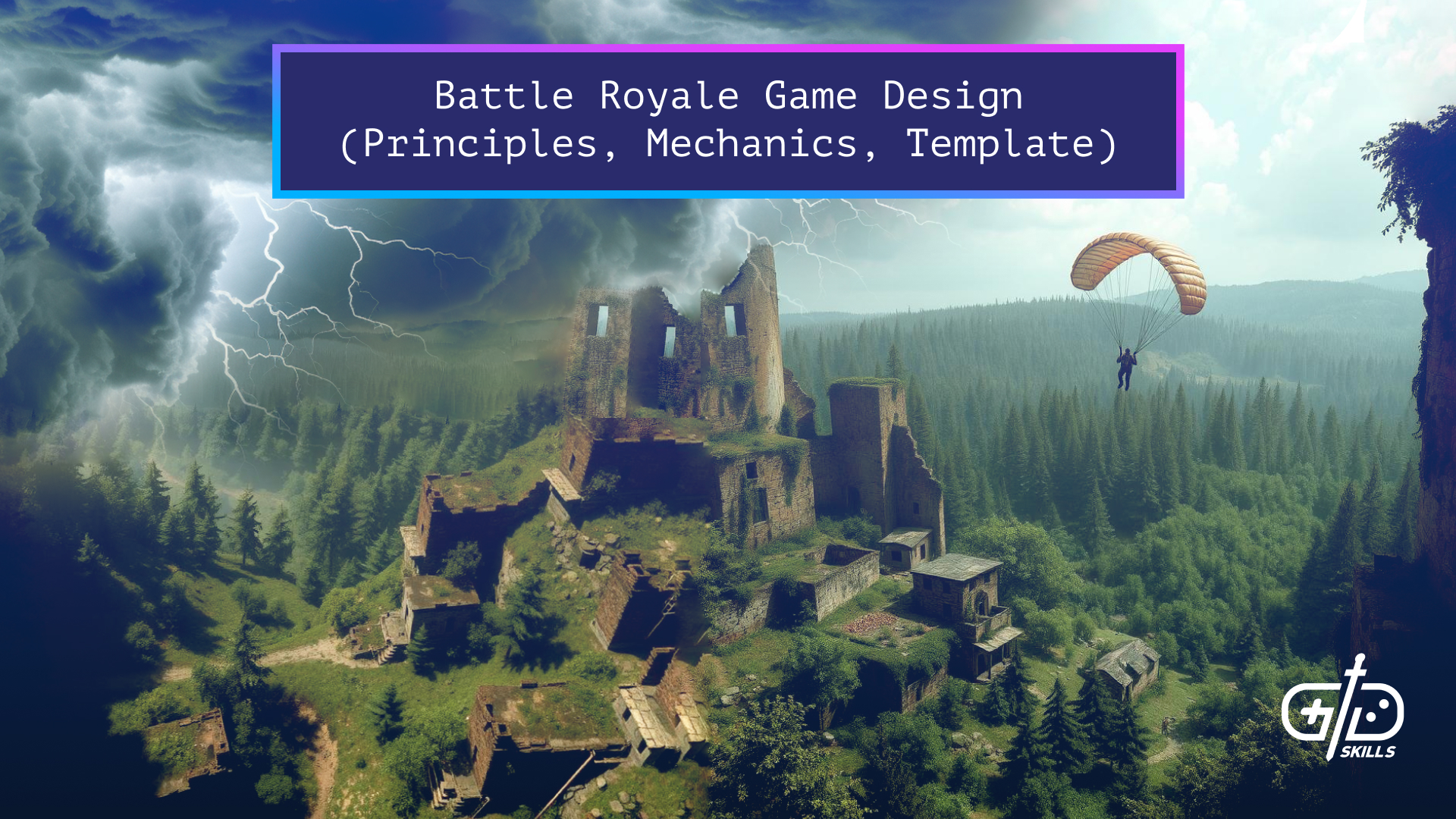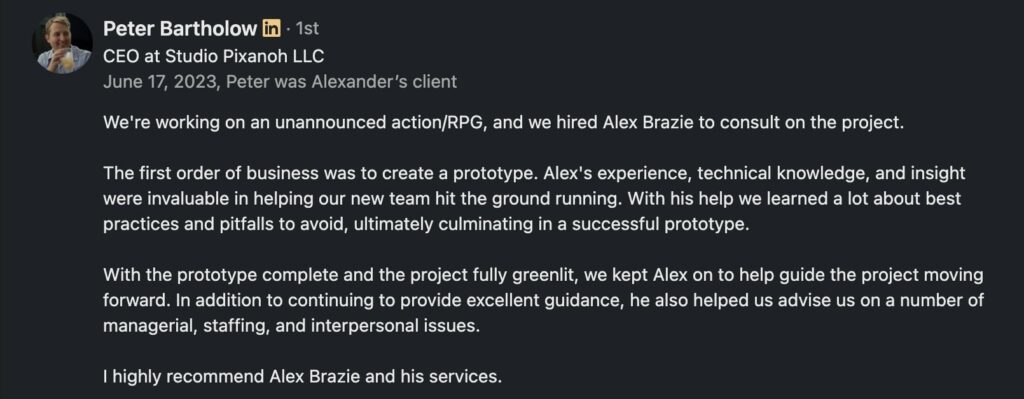Battle royale is a popular multiplayer genre that’s skyrocketed in popularity in recent years. While PUBG launched battle royale into the mainstream, Fortnite leveled the genre into a successful live service product. To learn what makes battle royale games distinct from other multiplayer games, step through the process at a high level. There are special challenges to consider in level design, as well as in designing the mechanics of a battle royale. Understand how matches work, what gear is common, and how to implement it.
No game design documents for a battle royale game have been published, and I’m not an expert in battle royales myself. There are, however, many sources online of templates, advice from devs, and innovative games to get inspiration from. Read on to learn more about all the available options and how to go from idea to execution.
What are the principles of battle royale game design?
The principles of battle royale game design are PvP free-for-all combat mixed with survival game mechanics. The chaotic, large matches mix with the mechanics to create a tense experience for the player. The basic rules of a match are the same in all battle royales, so learn about the general design principles. Seasonal content further works with the core game mechanics to keep players invested long-term.
Battle royale uses the survival game formula to give players a Hunger Games-style experience. Players manage resources and build an arsenal to take on other players who themselves become increasingly powerful. Engaging in combat comes with more risk than most competitive shooters, since players are out for good when they die. PUBG, Fortnite Battle Royale, Apex Legends, and Call of Duty: Warzone are the most popular examples of the genre. Each major battle royale features the principles below.
- Competitive free-for-all PvP combat
- Option for small-squad PvP
- Players starting with no weapons or gear
- Starts are even (same options for looting and progressing)
- Large map size, large match size
- Range of disruptions available to a player (guns, consumables, cooldown abilities, building, crafting)
- Shrinking safe zone which pushes players together
- Loot of different rarities spread throughout the map
- Low skill floor, high skill ceiling
Matches end when one player or team is left standing. Victory comes with tangible rewards. Victors earn currency for purchasing cosmetics and gain extra rewards through the battle pass. Victory in Fortnite grants players an equippable item that flaunts the player’s prowess. Victory comes within 15 to 20 minutes due to the shrinking safe zone.
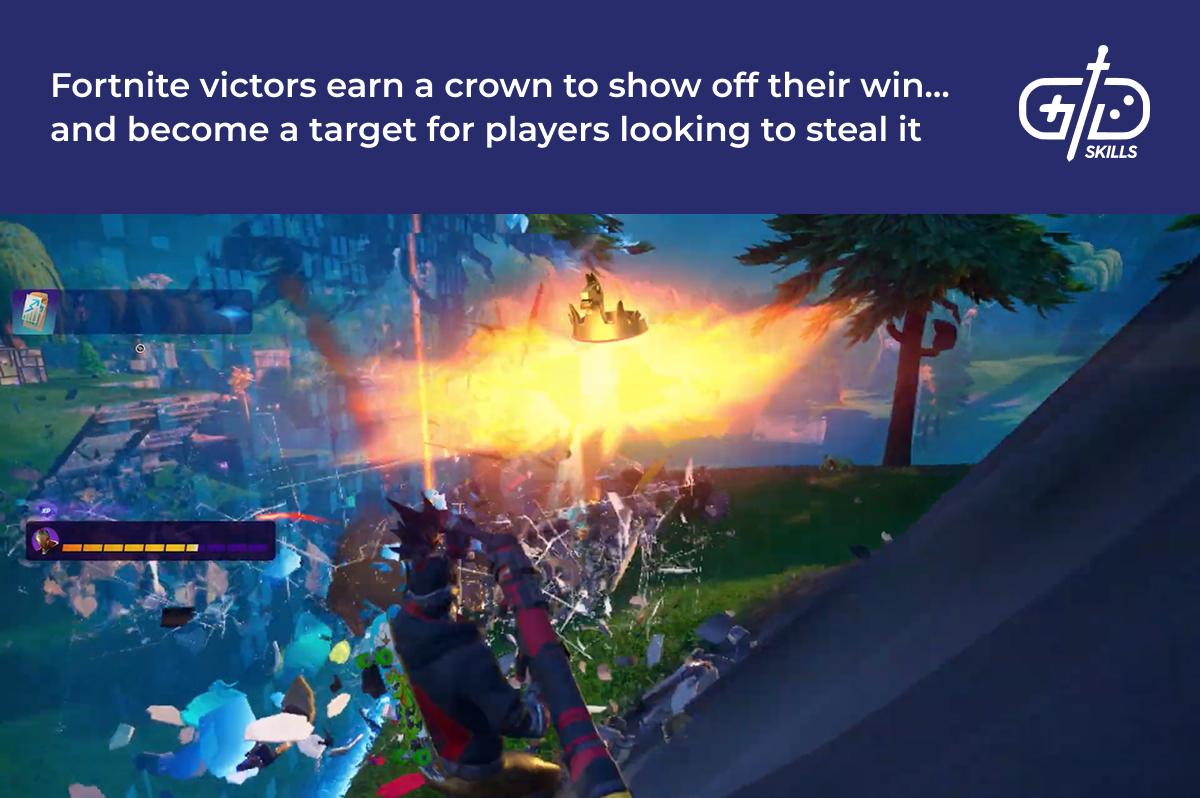
The map shrinks over the course of the match each round in all battle royales. A zone around the edge of the map appears after round one. The zone either damages the player or eliminates them if they spend too much time there. Players are forced into conflict by match end. The center of the shrinking safe zone is randomly selected each match, which adds an incentive to learn the map well, since players toward the edge of the zone need efficient escape paths.
AAA and AA battle royales are all shooters. Variations on the formula are rare, but some titles break through with different gameplay loops. Stampede: Racing Royale pits players against each other in races where only the top players move on. The game doesn’t even need an entirely new gameplay system, as players still compete in races to ranks as high as possible. The only difference is meta-game, the way each heat eliminates the lowest ranked players.
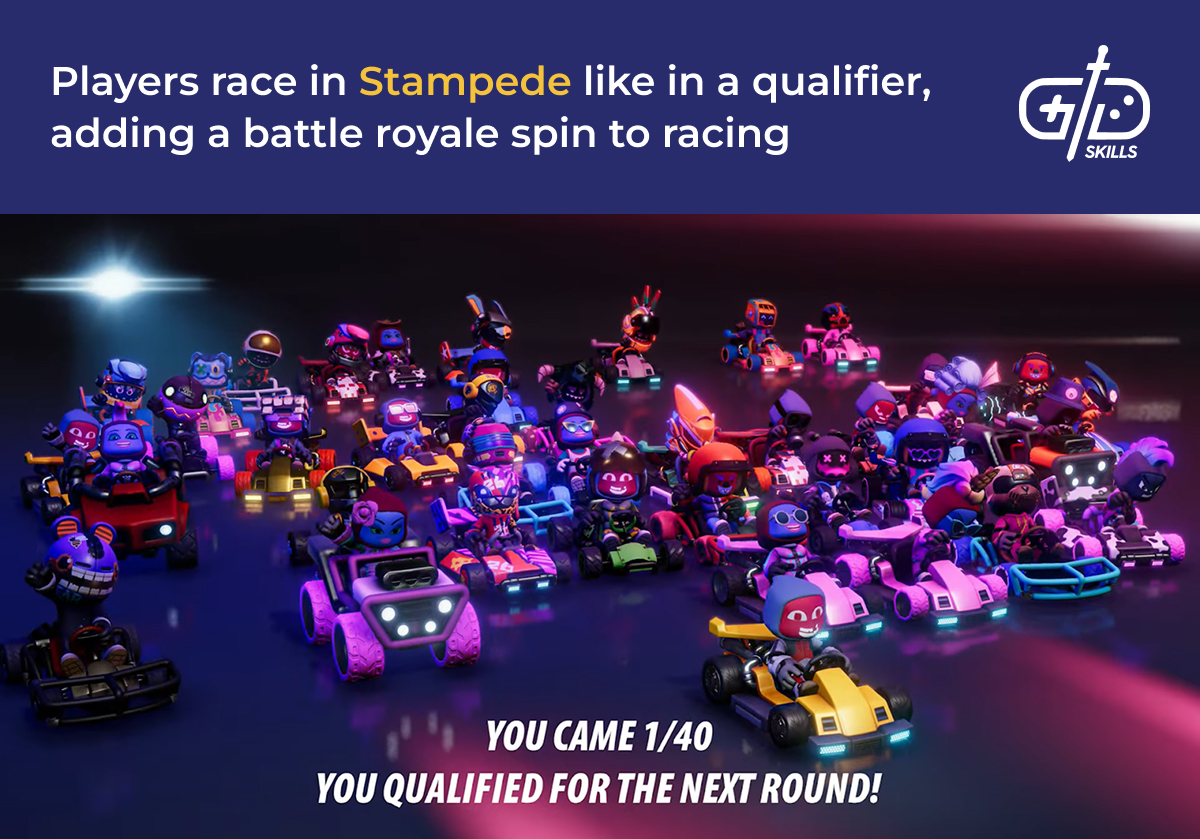
Solo free-for-all play is the norm, but all battle royales give the option for cooperative play. PUBG has game modes for duos or squads of 1-4 players. Squads of two or more are required in Apex Legends, since each player selects a specific class in the form of a Legend at the start of each match.
Battle royales mimic survival games such as Rust in their moment-to-moment gameplay. The fantasy of battle royale is to fight to the top tooth and nail, with whatever junk the player scrounges up. Players search for bandages, weapons, armor, and crafting materials for building structures, weapons, and consumables. Prominent locations provide better quality, military-grade gear, but attract other dangerous competitors as well.
The free-to-play model with in-game purchases dominates in the battle royale space. In-game purchases are strictly cosmetic to preserve the integrity of skill-based play. Players buy new skins and emotes for their character in the store, as well as weapon skins. New seasons bring new rewards to the store and keep the game fresh. Fortnite brings in partnerships with popular fandoms to renew interest for each new season.
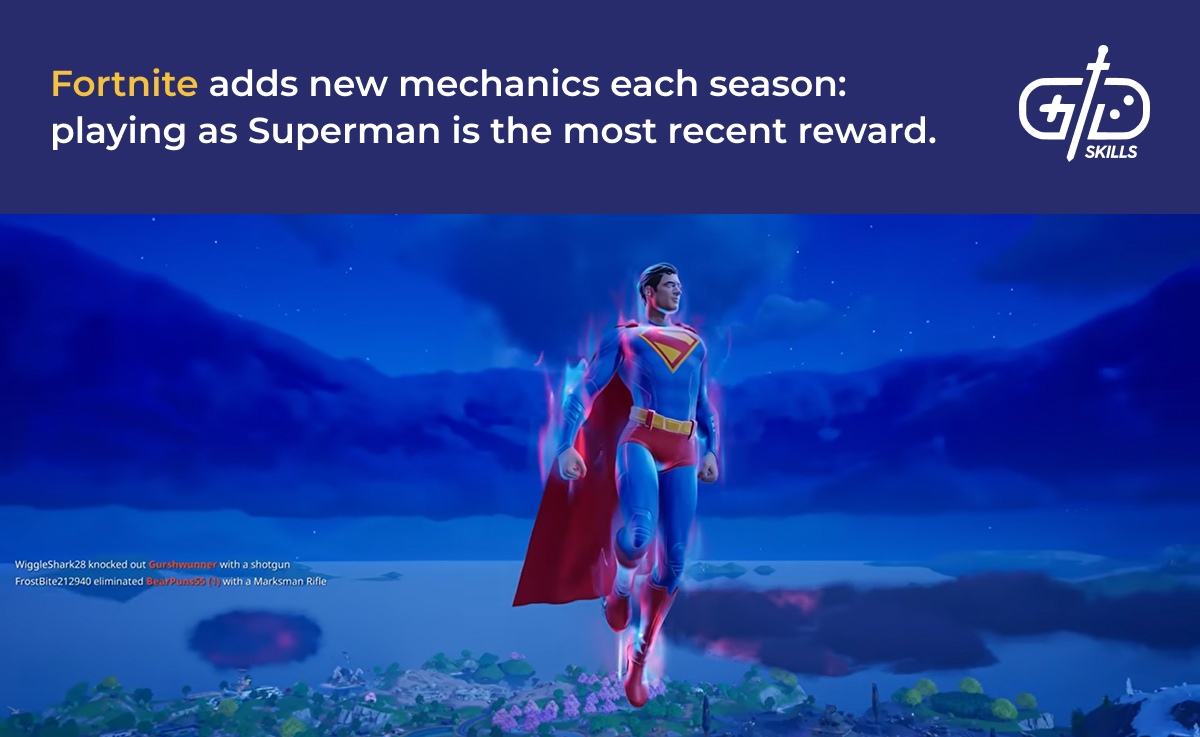
Designers moving from other multiplayer FPS genres need to consider upgrading server space. Matches for battle royale games range from 60-100 players. Brendan Greene, the creator of PUBG, had trouble paying for servers to host his original battle royale mod. The Irish welfare system ended up footing the bill. Bluespot had to upgrade their servers soon after the release of Greene’s standalone version, PUBG, since player traffic exceeded the expected 2 million players.
Every battle royale game goes beyond the general principles to make the experience unique. Experimental events and mechanics each season keep players invested in the game. Special types of air drops, bombing runs, new NPCs, enemies, or new progression systems add interest and anticipation for the next season.
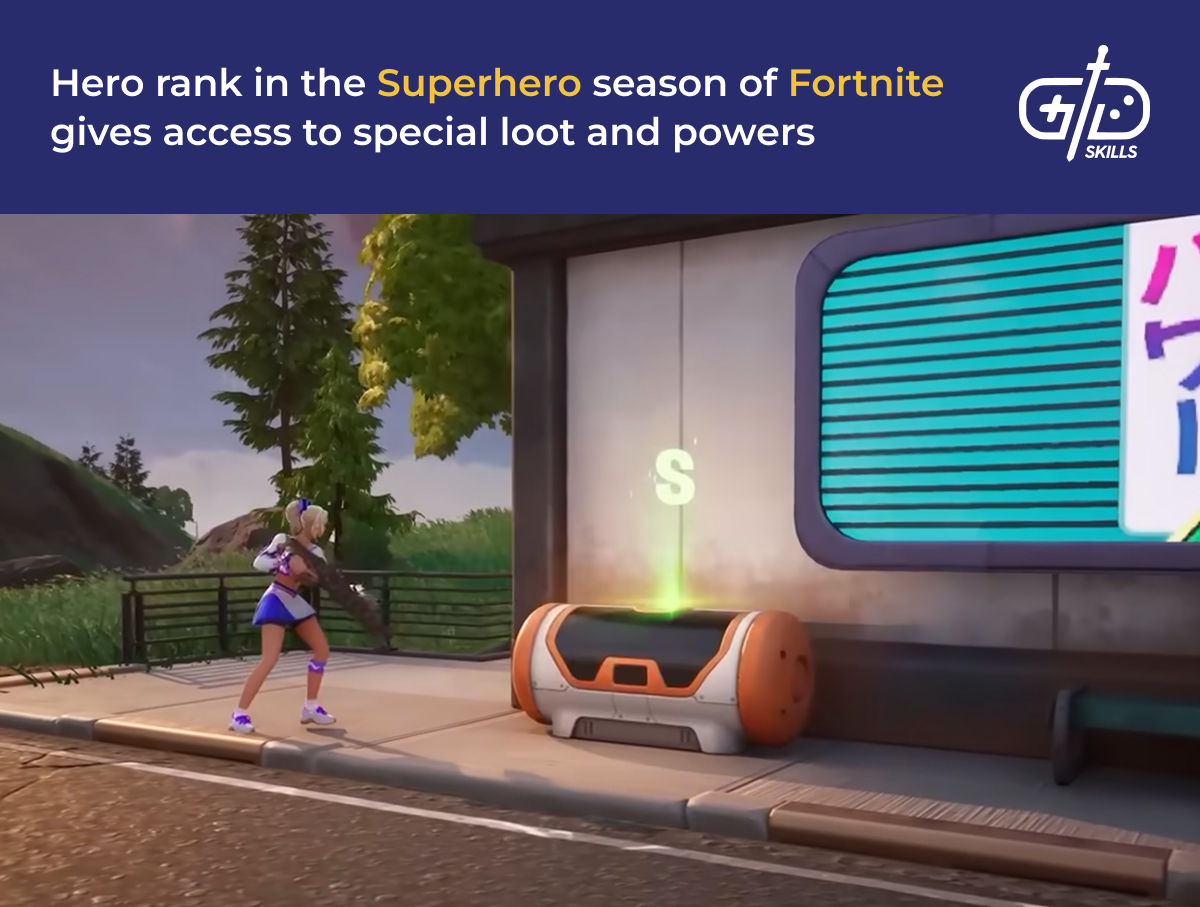
Battle royale’s core principals present unique challenges. Map designers must think like open world designers, not multiplayer shooter level designers. Designers in battle royale attract players to an arena, which is taken for granted in most shooters. The map itself isn’t a permanent fixture, either. A live service game requires new maps and updates every few months to keep players interested.
How to design levels for a battle royale game?
Level design for a battle royale game involves giving players clear options to explore without overcrowding the environment. The map needs to be big so players start with control over how to approach a match. Players who choose to bide their time and search for loot have room to avoid combat when they first drop in. PUBG maps range from 2×2 to 8×8 kilometers to support any playstyle. At the game’s sprinting speed of 6.3 m/s, it takes about 30 minutes to go diagonally across an 8×8 map, to put the size into perspective.
Diagram out the level first and make it dense despite its size. Players want to know there is loot over the horizon in any direction, so each landmark needs other visible landmarks 360 degrees around it. An empty map feels boring to navigate and spreads potential combat encounters too far away.
Don’t, on the other hand, fill the map only with dense hand-crafted areas. Cushion important locations with cover and environmental obstacles. Packing landmarks together not only disincentivizes exploration but means a lot of assets to load. Put trees, rocky terrain, hills, or unnatural pieces of cover such as trailers, camps, and overturned cars between landmarks. Cover within sprinting distance makes a player think, “this is dangerous, but I think I can make that.” The thought that loot is also waiting behind cover strengthens the urge to take a risk.
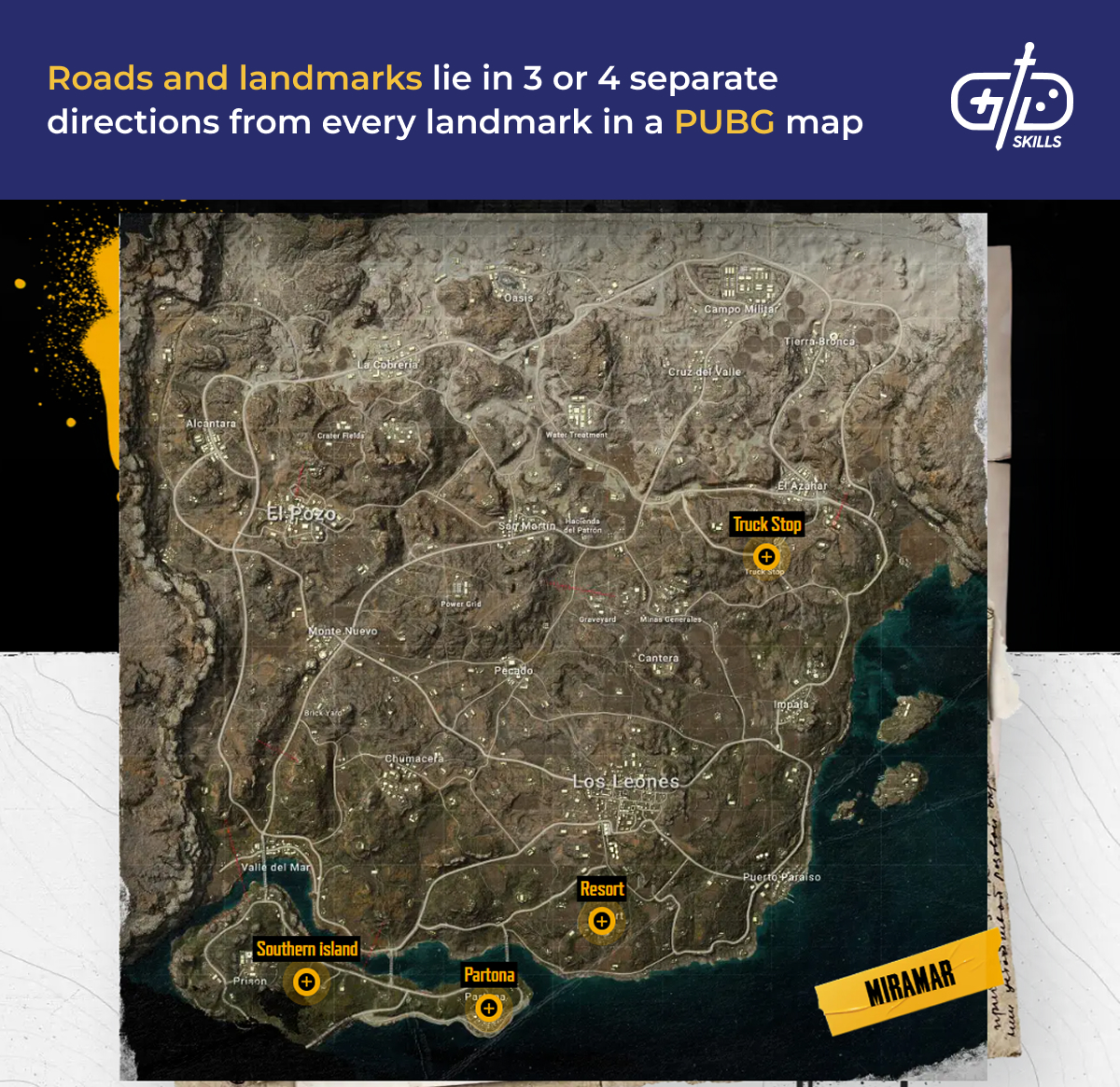
Landmark locations are notable places on the map. Landmarks signal high quality loot with the tradeoff that other players gather there as well. They are usually towns, camps, and bases. A game like Fortnite is more fantastical than PUBG, the former including locations such as the Demon’s Domain or a Star Wars First Order base.
Landmarks are crucial for the designer because they’re enclosed spaces. Designers are able to predict and plan for player interactions in them. Players move within landmarks in specific ways, with certain sightlines, and with the goal of approaching specific loot-dense locations. Designers further control the space by connecting the landmark to the rest of the map with a bridge or other environmental feature that guarantees one angle of approach. The cornucopia in The Hunger Games has a clear, obvious approach to the best loot, to take the movie as an example.
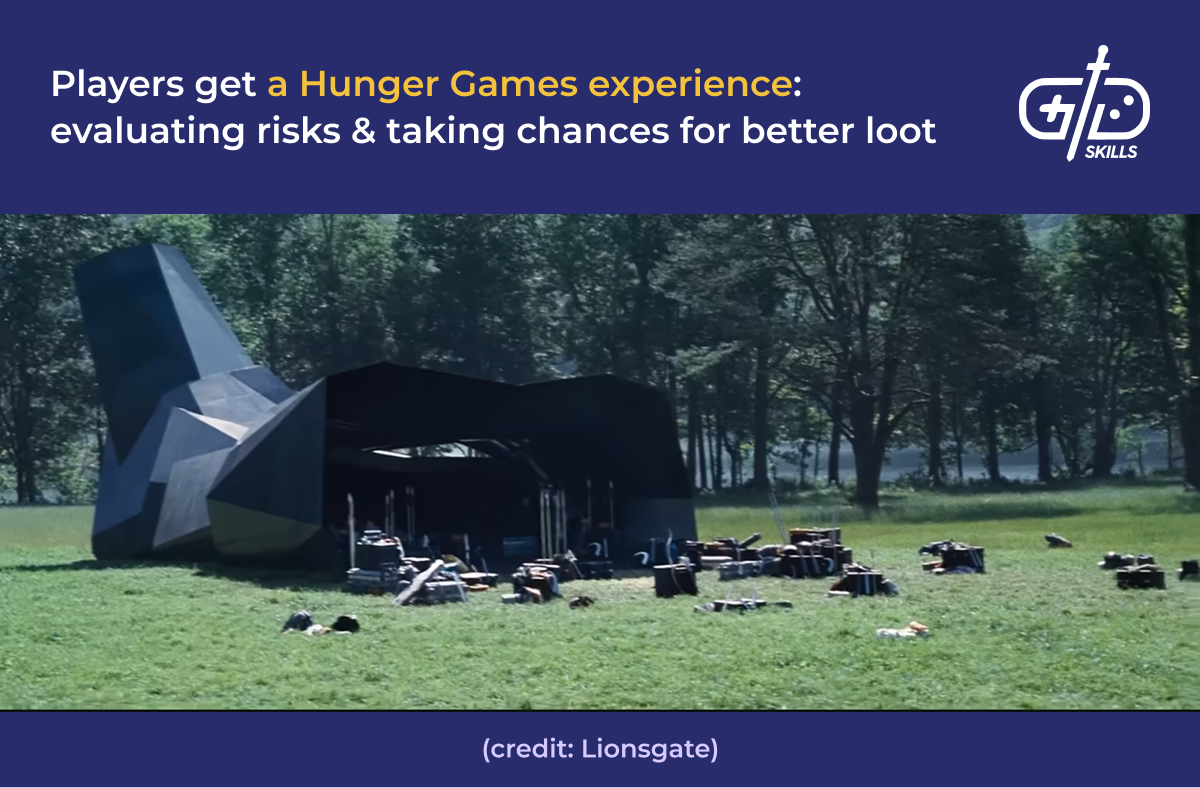
Perfection isn’t the goal at the layout stage of level design. Playtesting is required to tune the level to every playstyle. Snipers want effective places to nest and search for prey. Other players are close-range combatants who use their mastery of interior spaces to outposition and outgun their enemies. Stealthy players need brush to hide in, sizable towns to loot from, and lots of escape routes. Still others are explorers who enjoy finding every last detail in the map. Easter eggs and journal entries add to the anticipation for the next season.
Designers of battle royale games ask three questions when designing the landmarks themselves: they consider how a player loots the space, how a player defends it, and how a player attacks it. Clear answers to all these questions makes for a successful landmark in a battle royale map.
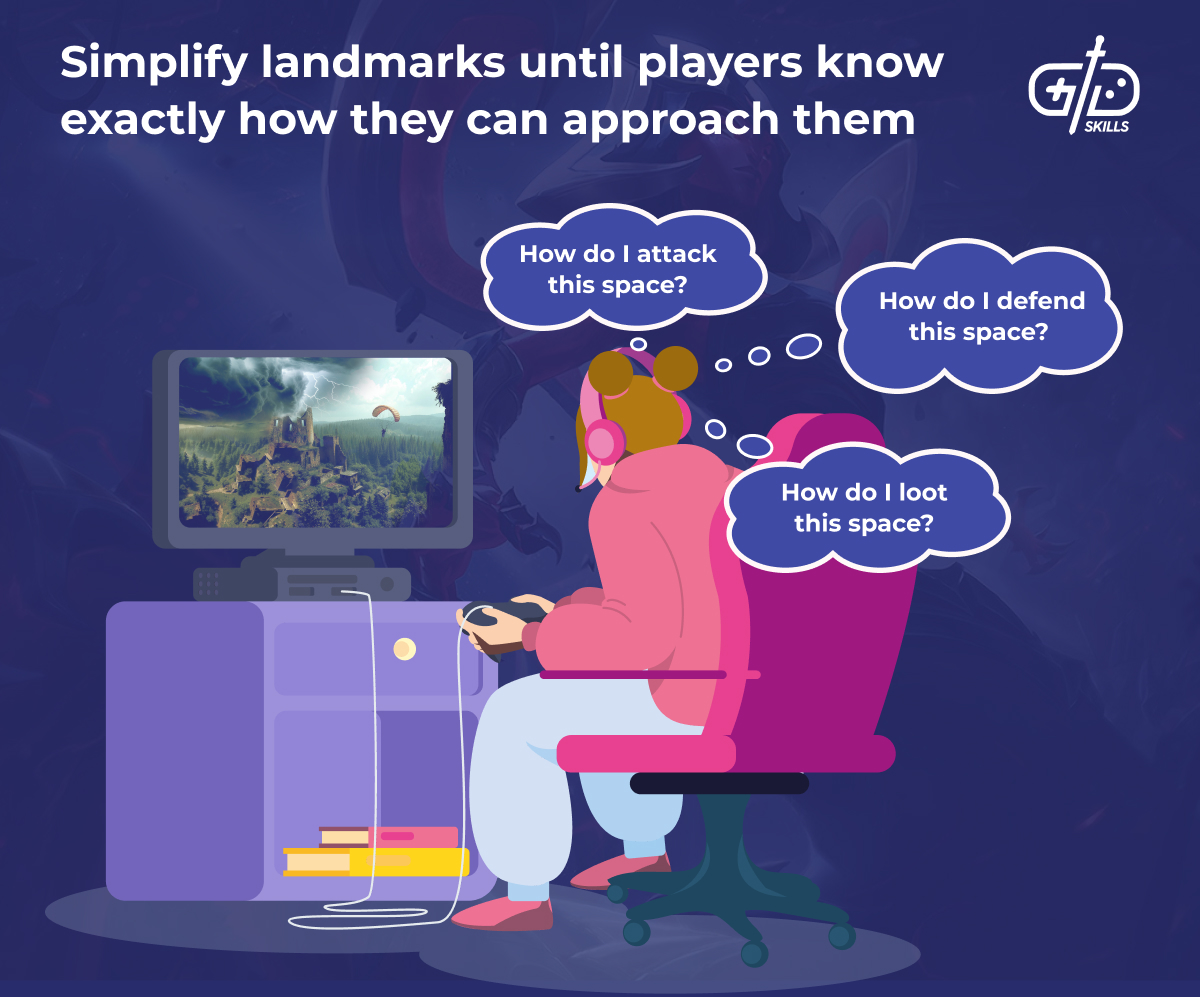
Simple interiors are best for ensuring players have clear answers to attacking, defending, and looting. Sound is an important reason simple interiors work, as Dave Curd from PUBG says. Skilled players use sound to locate nearby opponents. Simple and predictable building layouts help bat-eared players pinpoint opponents with precision. Uncluttered interiors have the additional benefit of making loot easy to separate from environmental detail.
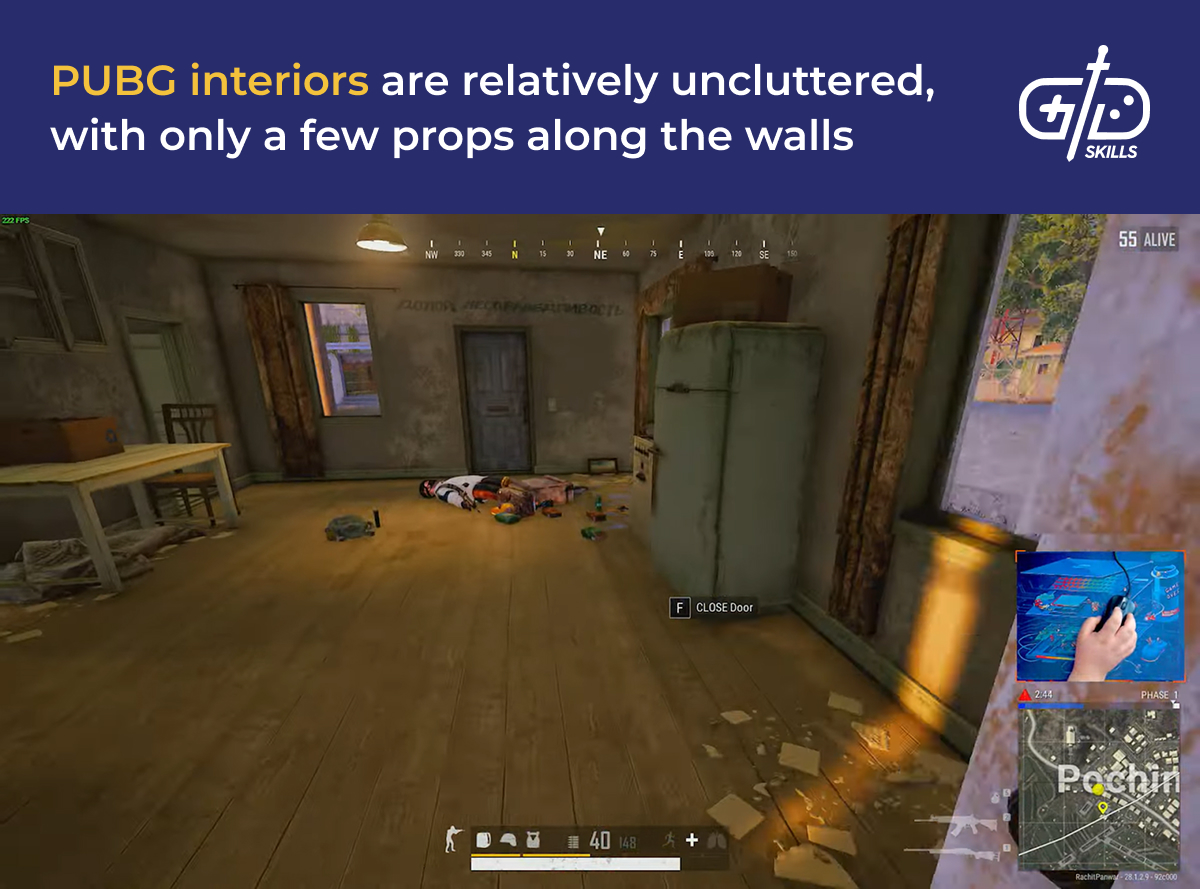
Climbable hills and buildings give players control over the level through information. Consider where players are able to get information about map layout and the locations of enemies. High points add the desired tension to a battle royale since they’re easily noticed. A player isn’t always sure they’re the first one there.
Biomes signal to players how to approach a situation in different regions of the map. They add more than simple variety. Players already have expectations about biomes: deserts have dunes, forests have trees, plains are wide open. Players encountering the map for the first time know how to use environments to their advantage without having ever played before.

Skull Town is a popular area in Apex Legends that shows the principles of an effective landmark: loot density, placement near other landmarks, and a distinct theme. The location includes several buildings criss-crossing each other. Players are able to snatch up loot quickly along pathways between buildings, but there is room for several other teams to avoid or ambush them. An interesting landmark in any direction from Skull Town is guaranteed for those escaping the claustrophobic settlement. The final positive is the area’s notability. Skull Town is obvious from above, with a mysterious large skeleton hanging over the x-shaped desert town.
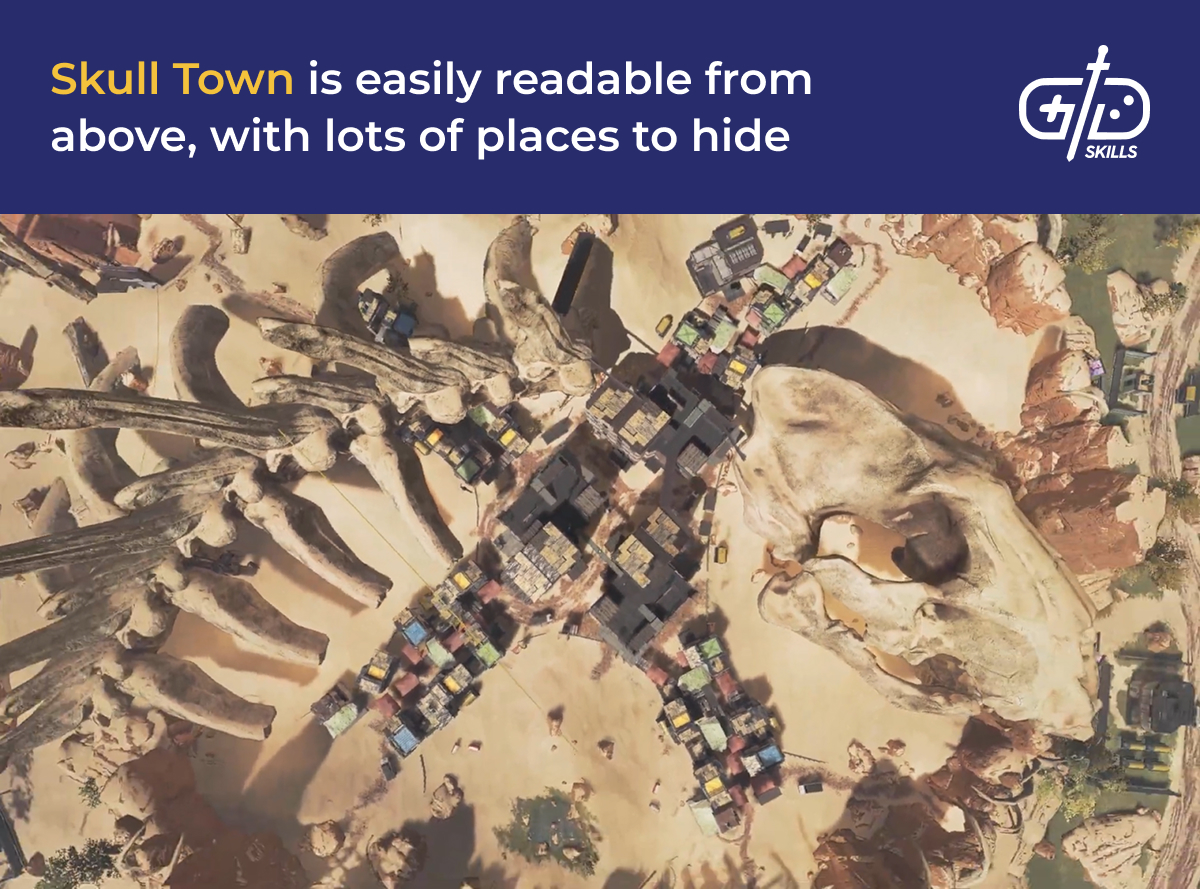
Long travel time between interesting locations takes players out of the game. Consider methods for speeding up travel in response to feedback. Ziplines are a mechanically interesting option. Ziplines make crossing large distances quicker and come with the drawback of exposing the player. PUBG gives players vehicles ranging from bikes to trucks for navigating the map and making the world feel lived-in.
The level needs more dynamic events than a shrinking safe zone to keep the map interesting. Dynamic events have the advantage of requiring no change to the map. Adjust the frequency and location of random events in response to playtesting. Parachuting supply drops are a common mid-match event in battle royales. Drops are highly visible, highly valuable, and highly dangerous because everyone is able to see the box parachuting in from above. Day and night cycles also make a map more dynamic by changing visibility.
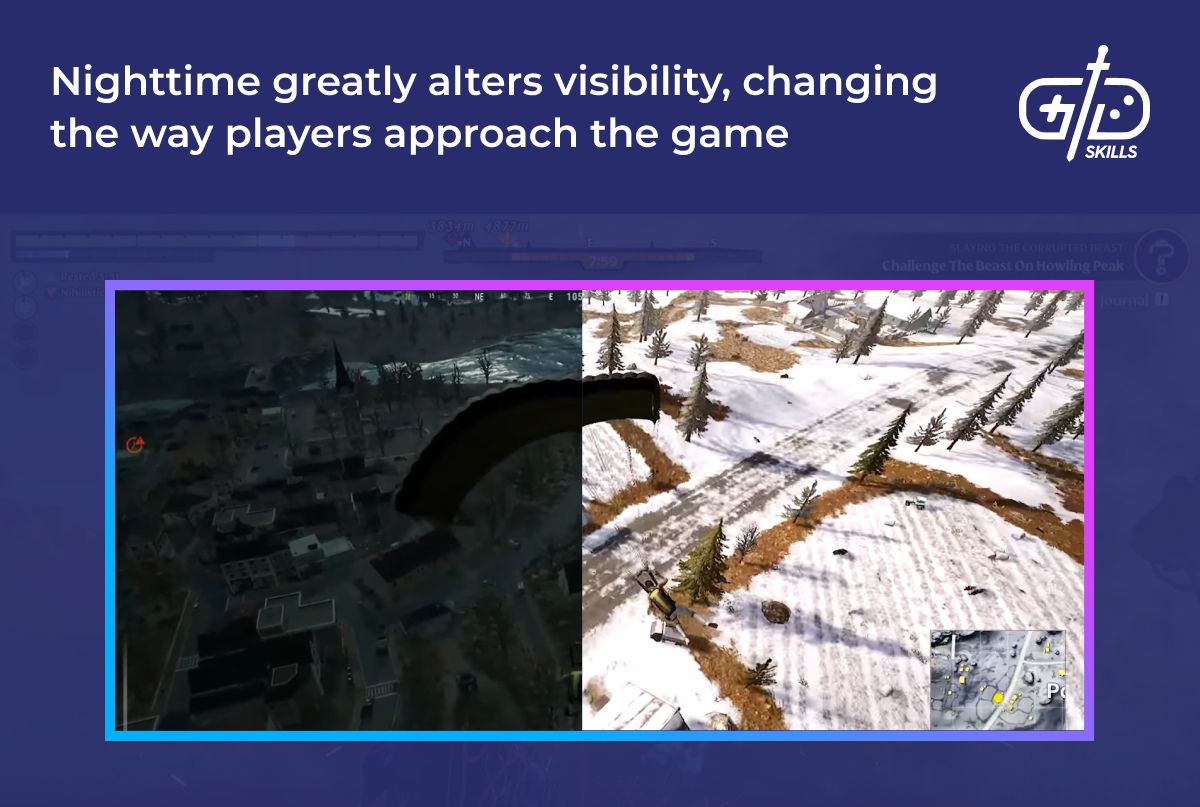
Add hazards to disrupt plans and add replayability where it’s needed. Sandstorms block views. Airstrikes force players to make an escape. Water is a potential hazard, and the designer must decide whether water is traversable or a deadly obstacle. Paramo in PUBG has a volcano whose lava flows block off different areas of the map each match, changing the game with each replay.
How to design gear for battle royale games?
Design gear for battle royale games by considering how to give the player a sense of progression during a match. Players acquire numerous weapons, armor pieces, consumables and single-use items as they scavenge the map. Players at the end of a match have access to a wide array of tactics to employ in combat.
Weapons are the first arm of battle royale’s core gameplay. Weapon roles are consistent across multiplayer shooters. Roles correspond to different ranges and firing speeds. A sniper is always a high range, low firing speed weapon; an SMG is low range, high firing speed. Different roles are important for a battle royale because players engage anywhere from hundreds of meters away to close quarters.
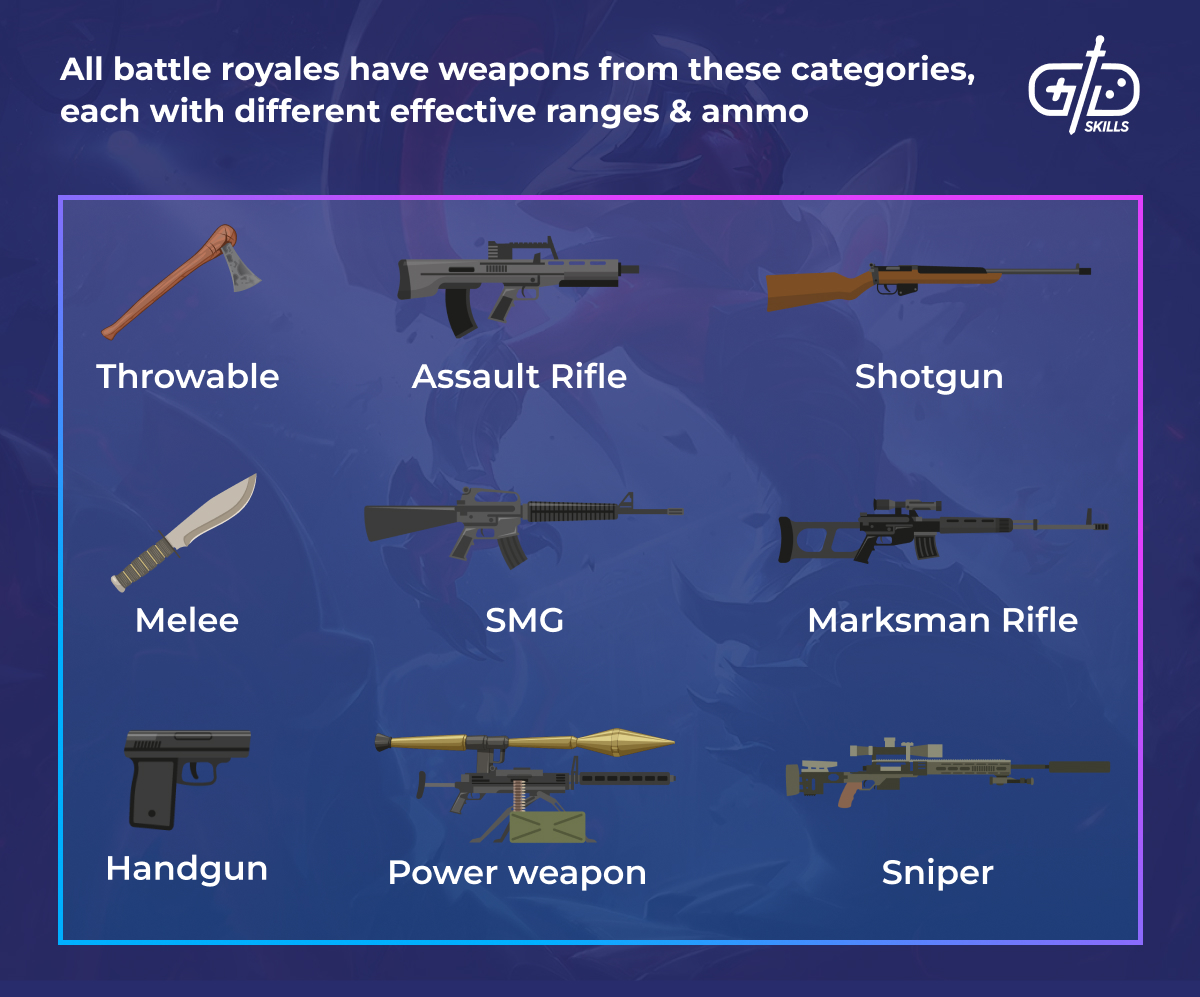
Armor is present in battle royale games to create a curve of increasing player resilience as the match continues. Armor comes in 3 or 4 rarities, with each one increasing resistances. Apex Legends expands armor to include several types of items with different effects. The variety increases the rewards for looting. Five gear slots are available in Apex Legends: helmet, shield core, knockdown shield, backpack, and survival.
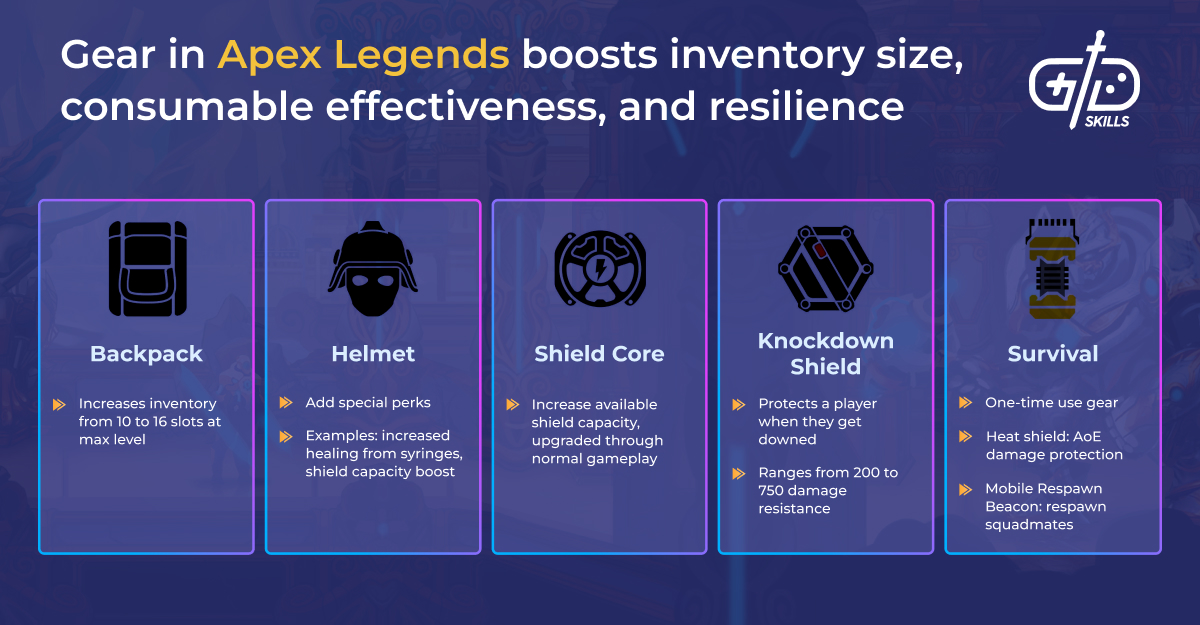
Armor upgrades either come from finding better armor through looting or earning experience points. Armor in Fortnite and PUBG comes in different rarities which alter their effectiveness. Legend armor in Apex Legends is an example of the latter system, where players naturally improve their armor through playing the game. EVO points, the XP, are earned by getting assists, earning kills, or finding EVO caches in vaults. Killing an enemy with a high EVO rank presents a player with a better reward. The better an enemy’s shield, the more armor their shield core restores when stolen.
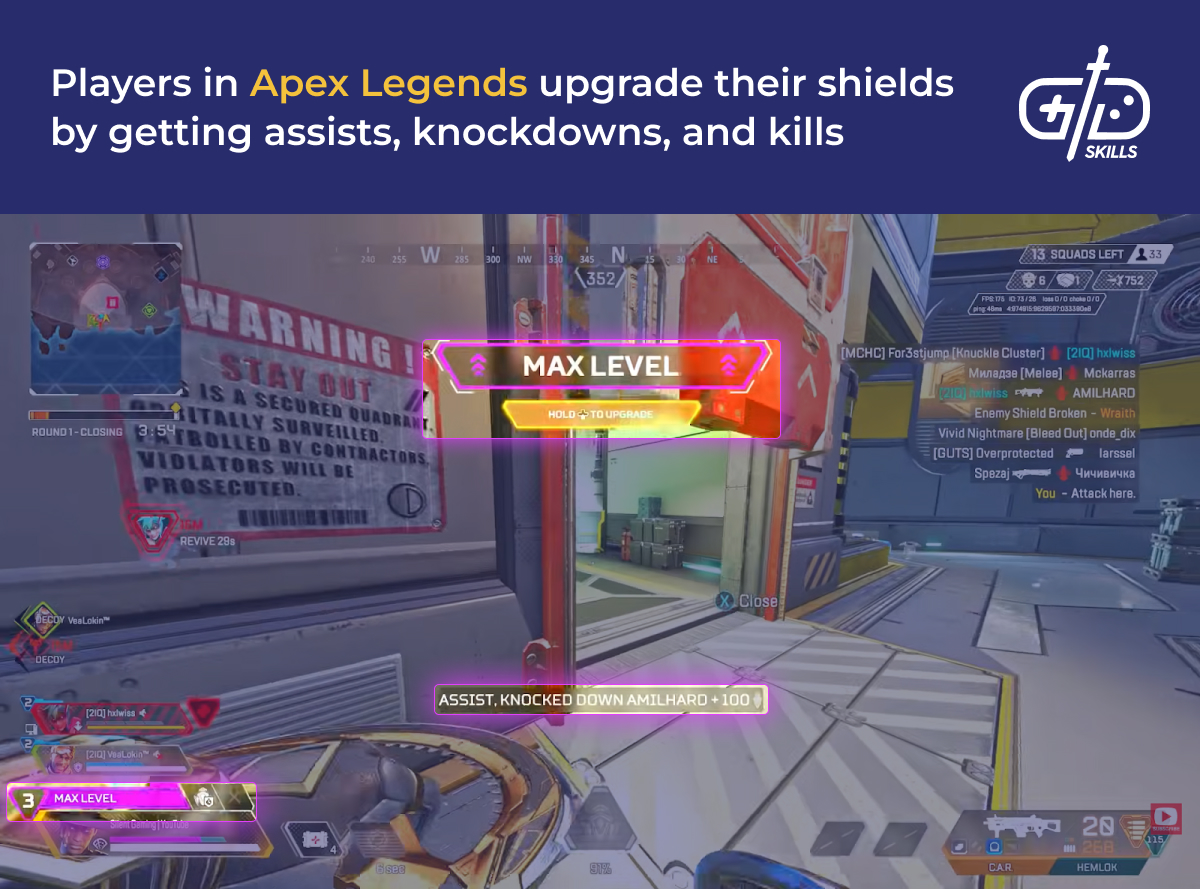
Healing consumables are universal gear in battle royales. Consumables are one-time use items that restore health. PUBG, a game more interested in a sense of realism, contains healing items which take several seconds to use and don’t restore health instantly. Apex Legends uses the same system for restoring shields, which encourages strategic use of consumables in combat.
Battle royale games have many single-use items in addition to heals. Shield batteries and cores give players the option to tactically recover shields mid-combat in Apex. Other items help the whole squad, which is more meaningful in squad-based game modes. Drop shields, AoE damage, and jump pads are available to teammates in Apex. Damaging consumables serve to give players options other than shooting as well. Grenades and other explosives create chaotic situations where players aren’t able to predict what tricks another player has up their sleeve.
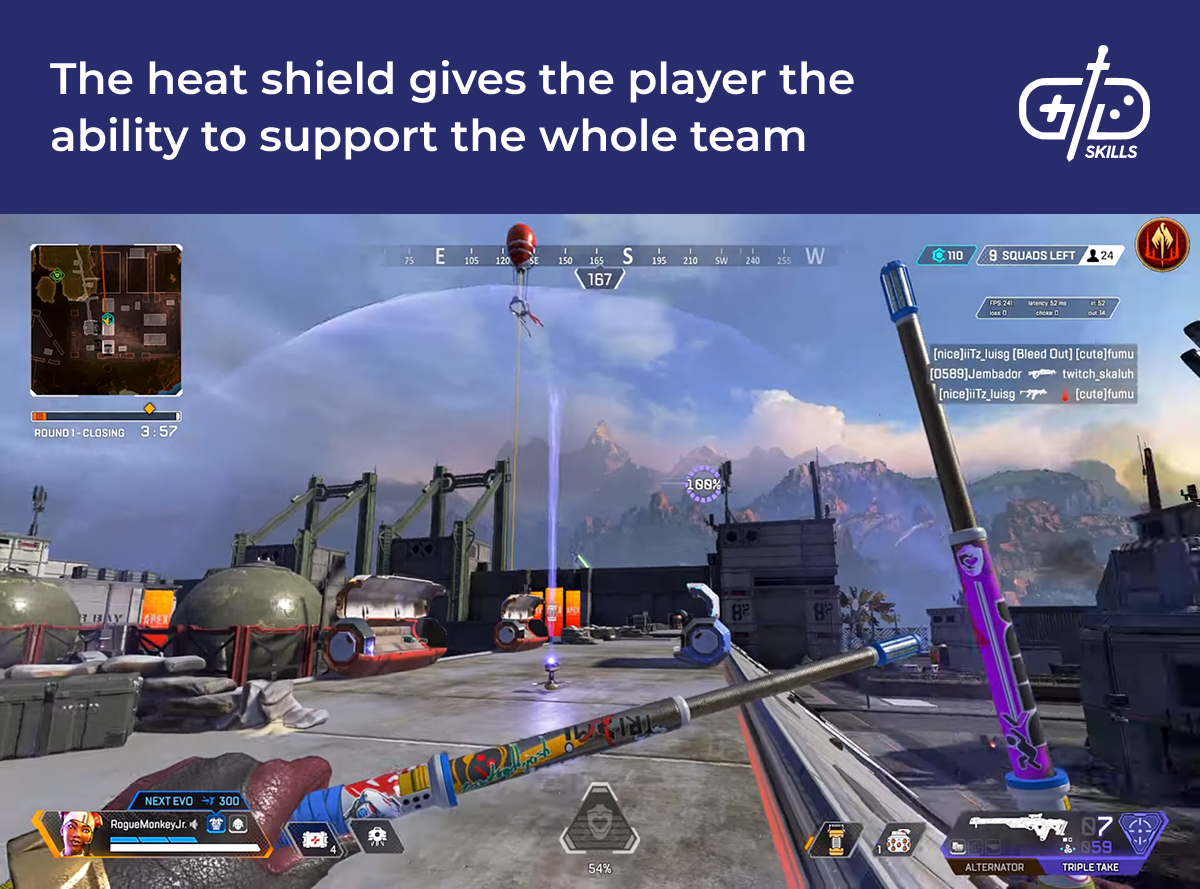
Gear comes in rarities so players know what to expect. Players learn what locations and boxes contain better loot through experience. Chests always have better loot than common gear found on the ground, supply drops have better gear than chests, and bosses have better gear than supply drops. A player going for contested locations doesn’t want to risk the match for common loot.
The goal of rarity is to communicate item quality immediately. Color-coded loot allows players to quickly scan for what they need. Fortnite uses more subdued colors for low tiers, such as gray and green. Yellow, orange, gold, purple are reserved for higher tiers. A metal system (bronze, silver, gold, platinum) is another possibility.
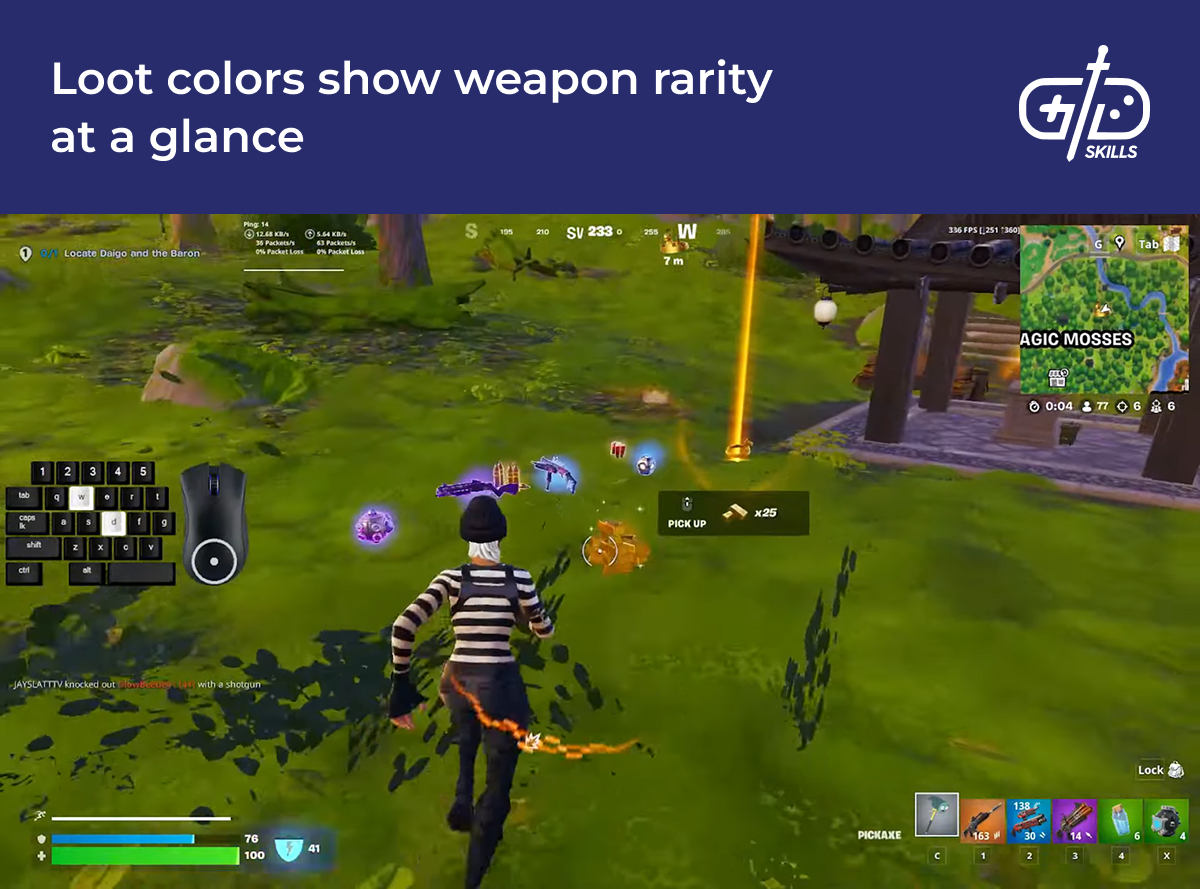
Rarity gives an incentive to keep looting and killing players. The chances of having the best version of each item is effectively 0, with 5-7 rarities for each piece of gear. Better loot is always available. The highest tiers even come with properties not found in lower quality gear, like level 4 loot in Apex Legends that has special perks.
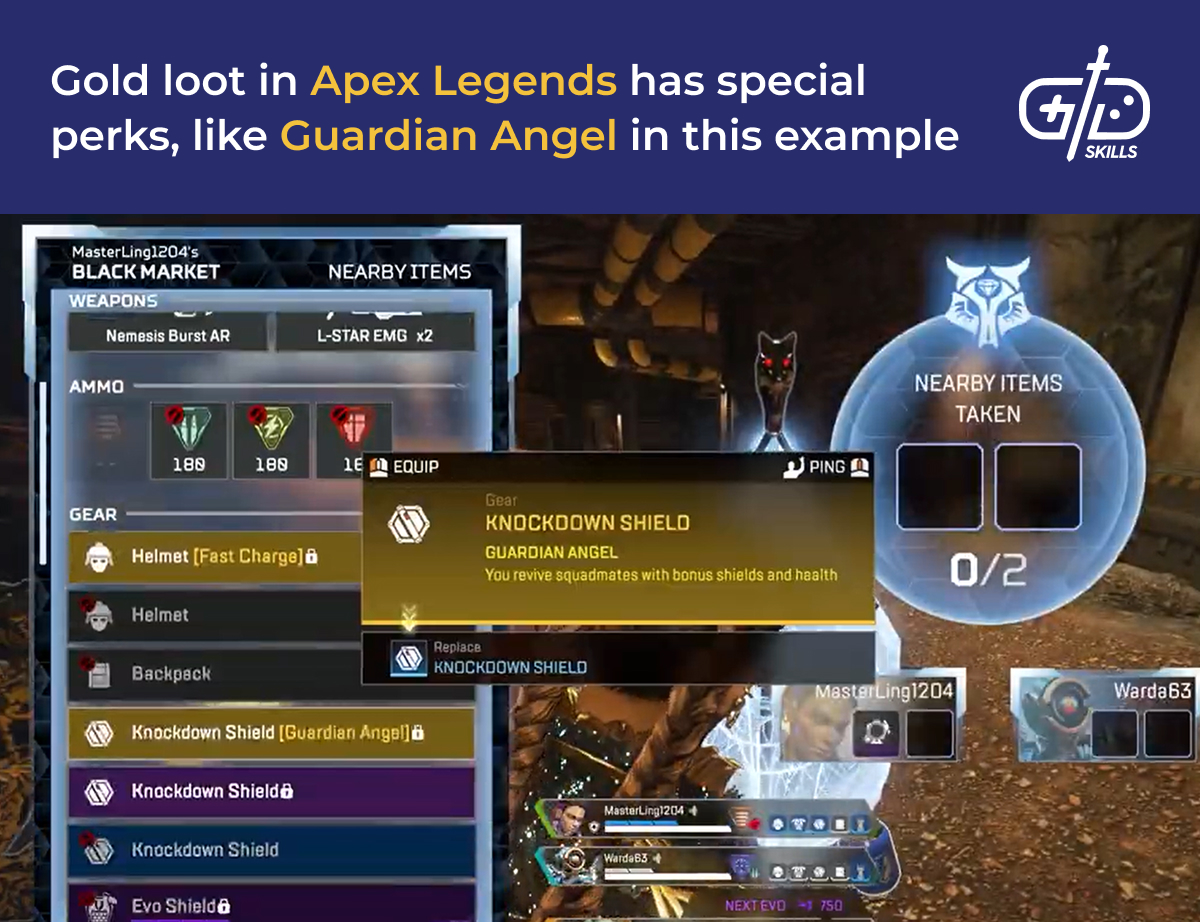
The only constant in loot distribution is change. All players start with nothing, so loot generation determines how players access every piece of gear in the game. New seasons bring new loot tables for chests, ground loot, air drops, and so on. New items get added to the loot pool, and designers have the chance to restrict or expand player access to gear based on data from the previous season.
Gear customization is strictly cosmetic in Battle Royale games. The type of cosmetics available depend on the type of experience. Fortnite is a game aimed at a general audience of all ages. The skins often come from tie-ins with other popular franchises: Marvel heroes, Superman, Halo. PUBG is a realistic game where skins mimic real-world fashion. Hats, masks, jackets, shirts have a series of colorful skins and images available.
How to balance gunplay for a battle royale game?
Balance gunplay for a battle royale game by communicating clear weapon roles to the player. Weapon roles are similar in all shooters, but it is up to each game to make each gun feel different. Once gunplay feels good, consider mechanics specific to battle royale games. Looting and consumable items prevent players from predicting exactly what their opponent does next. Integrate feedback from playtesters to further improve weapon design.
Balancing gunplay for a battle royale game begins with responsive movement and feedback, as with any shooter. Everything else that follows visual feedback is tweakable with hotfixes and likely to change from season to season. Balance is thought of in terms of difficulty or fairness, but balancing is more complicated than that. Designers bring players in and out of a flow state. Sometimes the game is easier, sometimes it’s harder, but the game ideally matches the player’s skill level as much as possible.
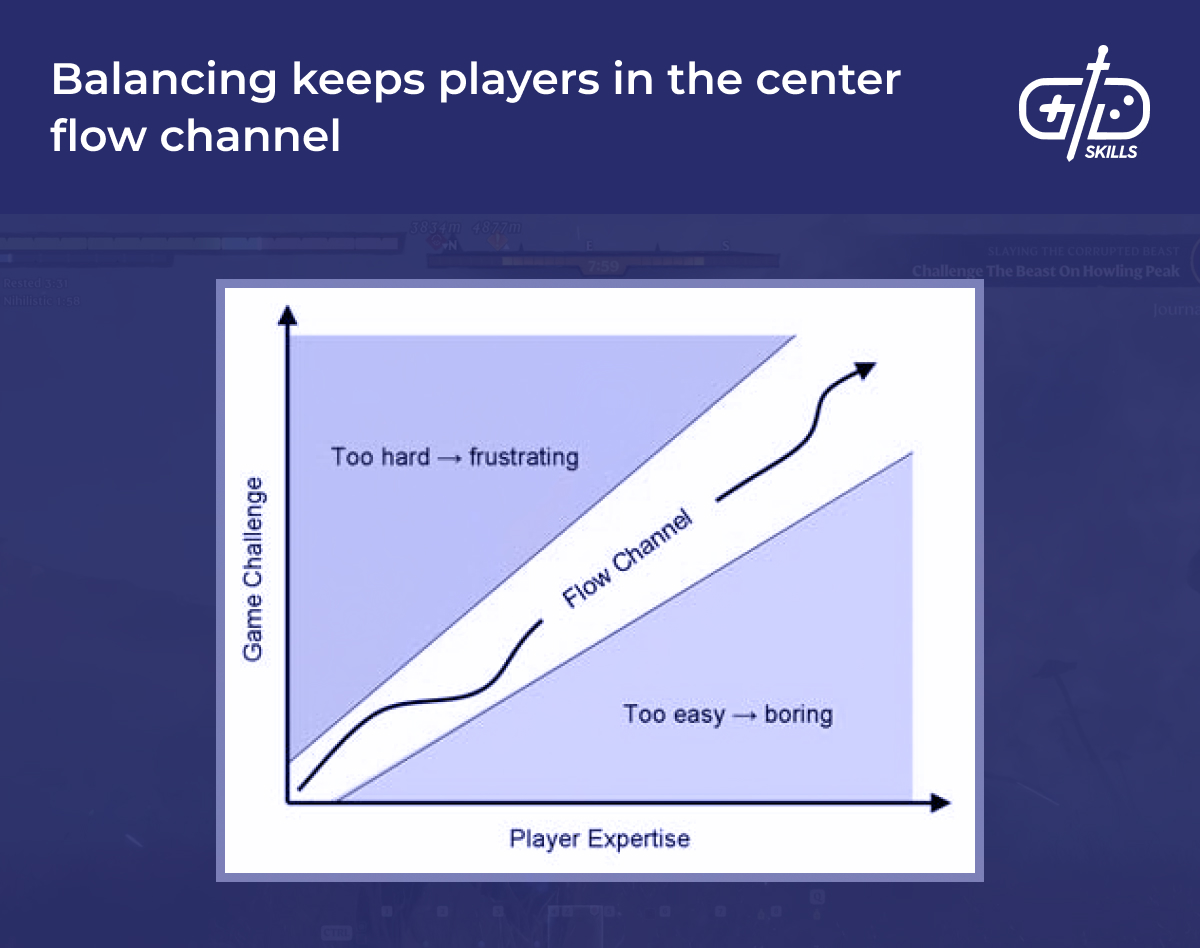
Weapon balancing begins with the weapon’s appearance. Players have trouble interpreting fine differences between numbers, so guns need to clearly tell players what they’re doing through animations and visual design. Jaime Griesemer of Bungie said that weapons should pass the “YouTube test.” The Halo sniper has long trails behind shots and special ragdolling animations from headshots. Shortly put, balanced weapons look cool!
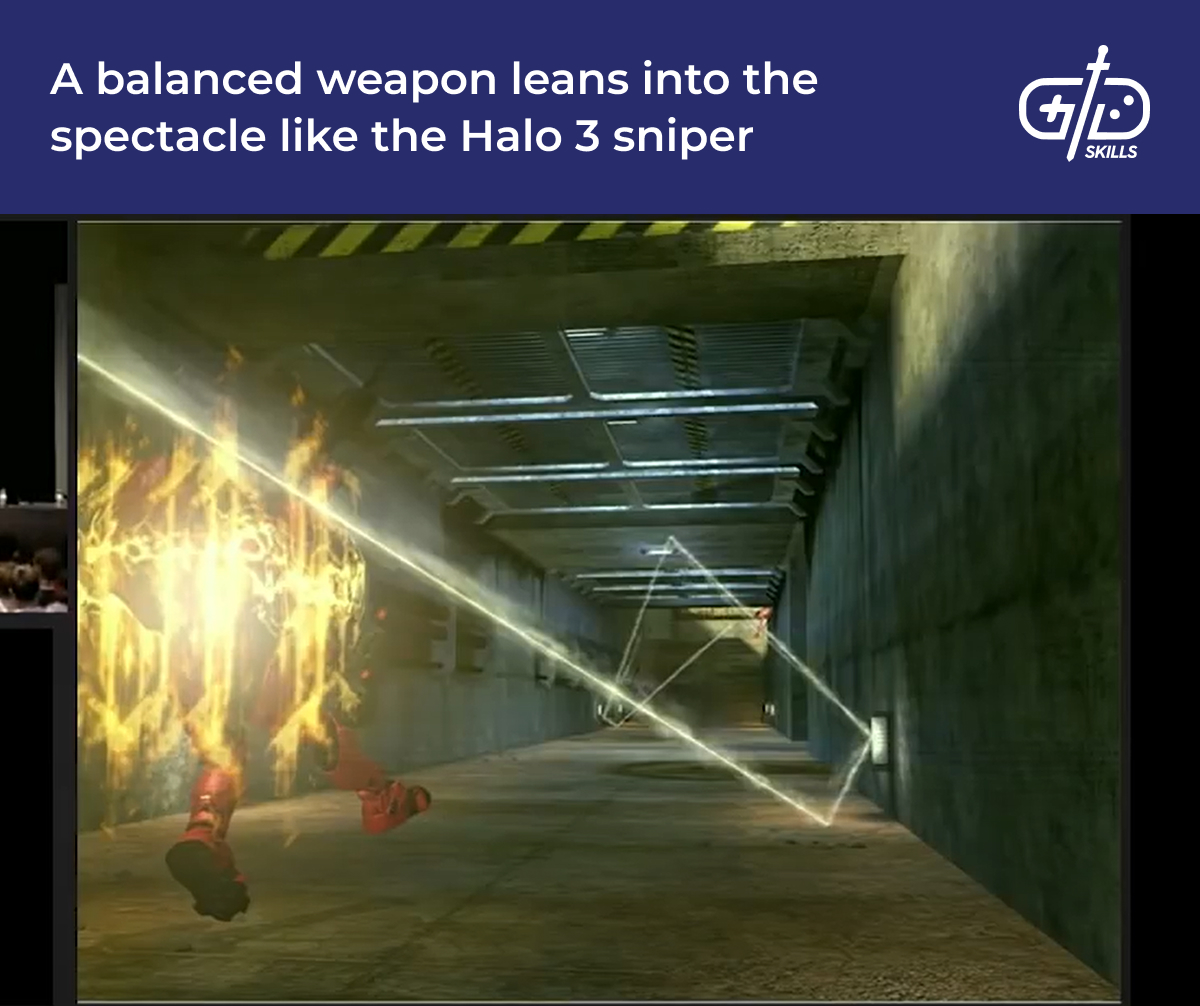
Exaggerated visuals associated with a weapon make the player’s effect on their environment clearer. Get the sounds and animations right first before tweaking values, since these are what give the player feedback on their performance, not the fire rate or damage. Designers have fixed weak weapons and abilities by giving them a louder, more impactful sound but leaving damage alone. Recoil, muzzle flash, blood effects on enemies, staggering animations on impact, bullet decals on the walls tell the player they are hitting an opponent with a deadly weapon.
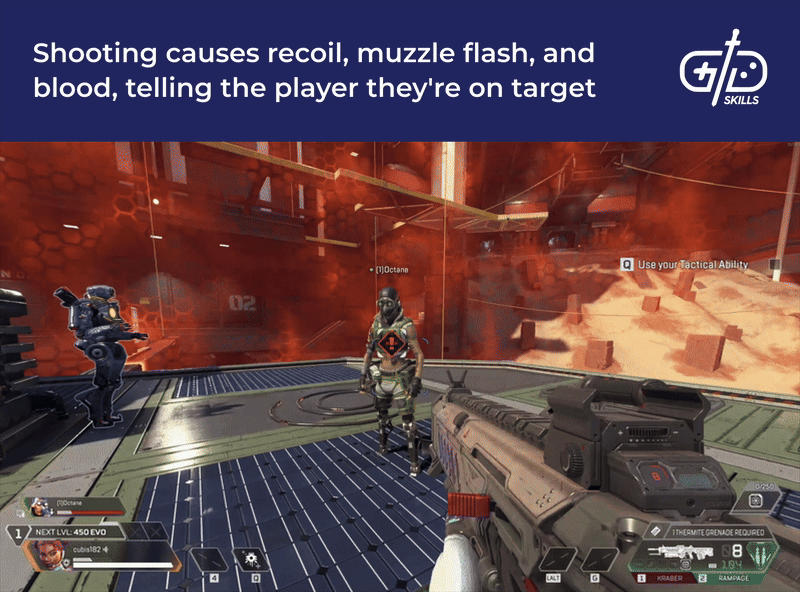
The gunplay needs to feel correct before balancing takes place. Map out how each action interacts with every other action. List an input, and then every other input a player is able to hit at the same time. Think about what a player expects to happen if they hit the grenade button while ADSing (Aiming Down Sights). Doing this either takes the player out of ADS, or does nothing. Map out what happens when a player in ADS jumps, reloads, melees, sprints, and so on until all the possibilities have been accounted for.
Balance begins with giving weapons clear roles. Clear weapon types mean players don’t second guess how to respond to an enemy. Snipers are hard to control at close range, SMGs have poor spread and damage at long ranges, and shotguns are effective only at close quarters. Players have an instant idea how to counter each opponent when they see their weapons.
Clearly defined roles don’t eliminate room for creative new additions to the sandbox. New special weapons added each season subvert the status quo in a refreshing way. They change up player movement or tie into a new mechanic for that season. The grapple gun, the Venom grab attack, and the Hunter’s Cloak for taming animals are examples of weapons added for special events in Fortnite.
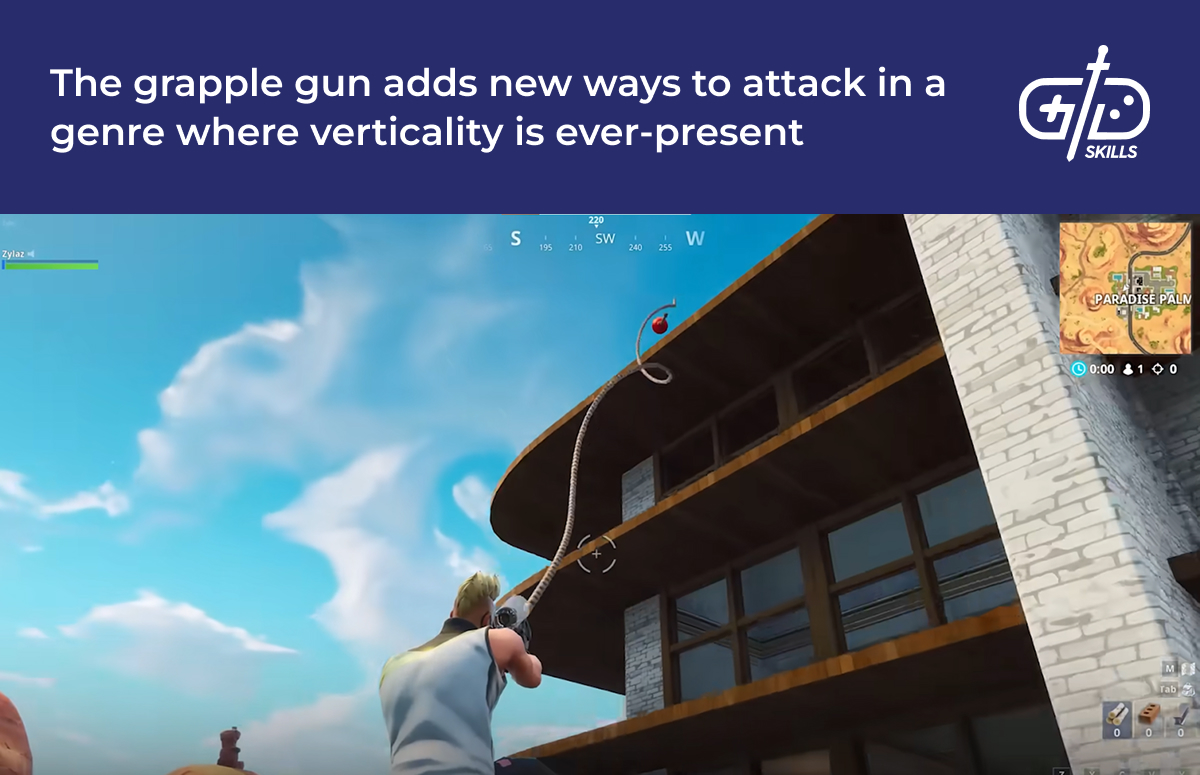
Consider finer details in response to testing once clear weapon roles are set. Time to kill (TTK) is the primary influence on damage. Each weapon takes a certain amount of time to kill an enemy if every shot hits. To keep TTK consistent, a slower attack does more damage than a quicker one. PUBG has a fairly quick time to kill, and, without any upgraded gear, a headshot is instant death for an Apex Legends player.
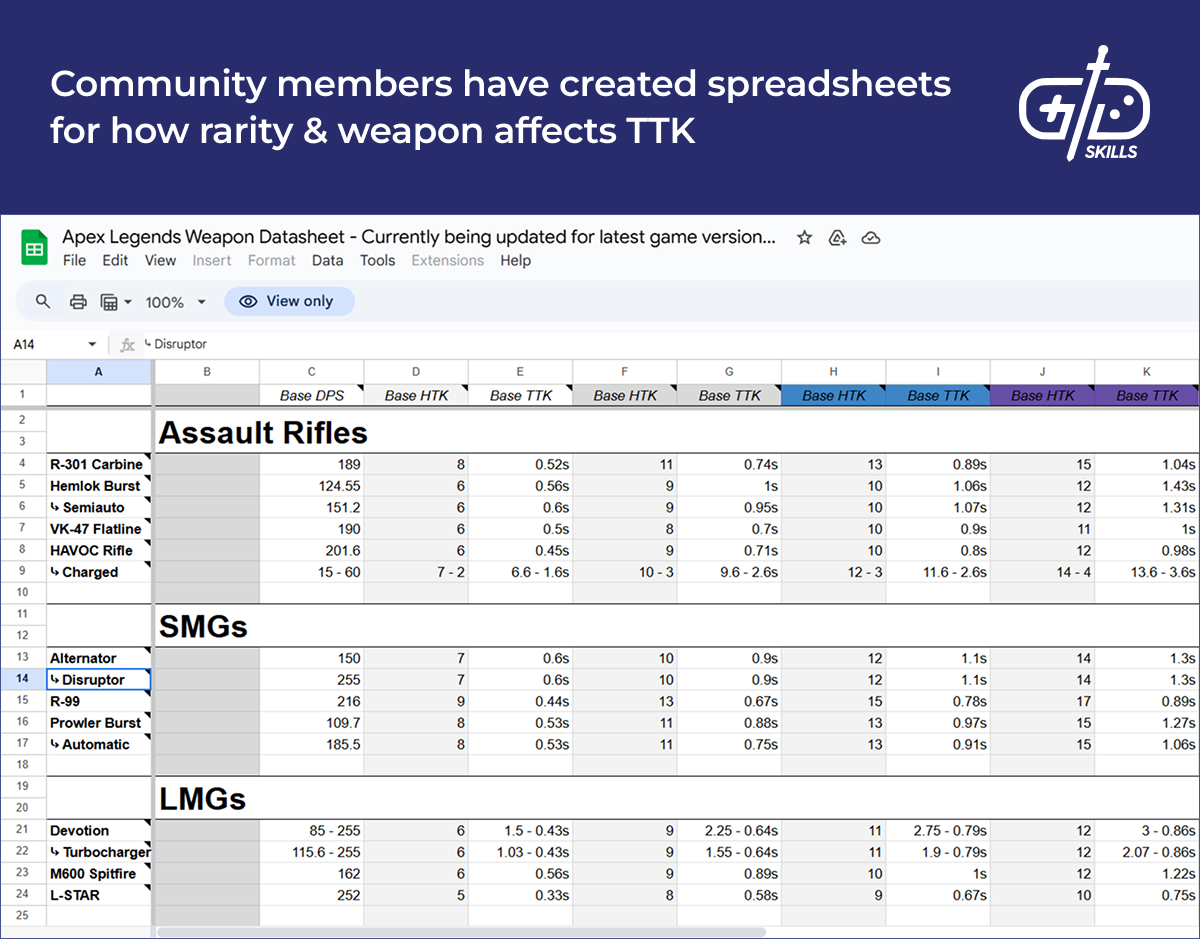
Adjust damage directly when damage is at issue. Fire rate, magazine size, and accuracy affect damage indirectly, but it’s best to target the core of the problem. Up or lower the damage if it’s not matching the strengths or weaknesses intended for the weapon. Changing fire rate for the purpose of reducing or increasing damage risks confusing the roles of weapons.
Battle royale designers aiming at the competitive market consider whether to use random or set weapon spread. Spread is how far shots stray from the center of the crosshair. Automatic weapons have higher spread than semi-automatic weapons, for example. Some shooters, most famously Counter-Strike, have a set spread pattern which experienced players memorize to maximize accuracy. Set spread makes the game more competitive and less casual. The PUBG designers used random spread in their game because they were concerned with cheating tools replicating the pattern.
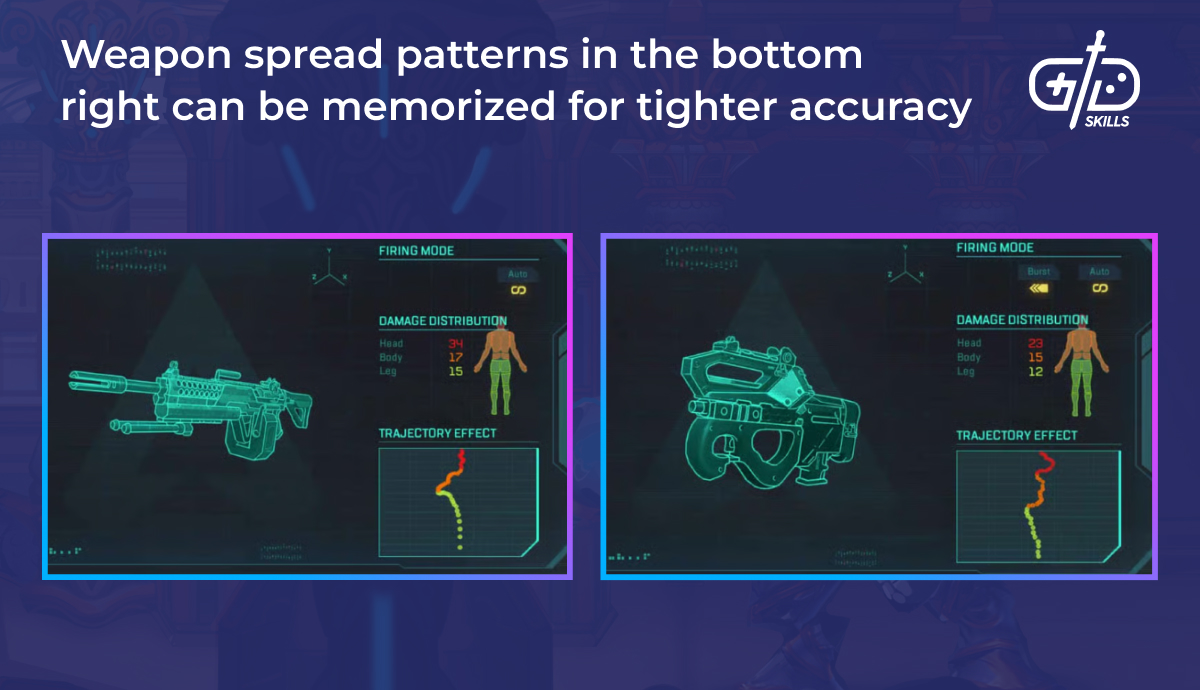
Consider ammo scarcity when balancing gunplay. Battle royales are survival games where players need to scavenge for resources. Scarcity of ammo forces players into conflict over limited supplies, and encourages careful management of resources. Abundant ammo, on the other hand, makes all-out firefights easier and shifts the resource management to other priorities (consumable items, crafting materials).
Allowing higher quality drops on the ground balances the game toward more casual difficulty. Players don’t have to be skilled at combat to enter and exit open locations, so putting better weapons in the open puts better gear in the hands of players at any level. Even gear distribution across the board reduces the role of player skill, so battle royale games tend to keep the best loot in predictable, easily visible locations.
Abilities, consumables, and attachments allow players to adjust the difficulty of the game. Randomization of weapon rarities and types already creates hundreds of possibilities. Numerous attachments add even more emergent gameplay. A silencer for a long range weapon changes how aggressive a sniper is allowed to be without alerting nearby enemies. A laser sight on an assault rifle allows a player to play more carefully from farther away.
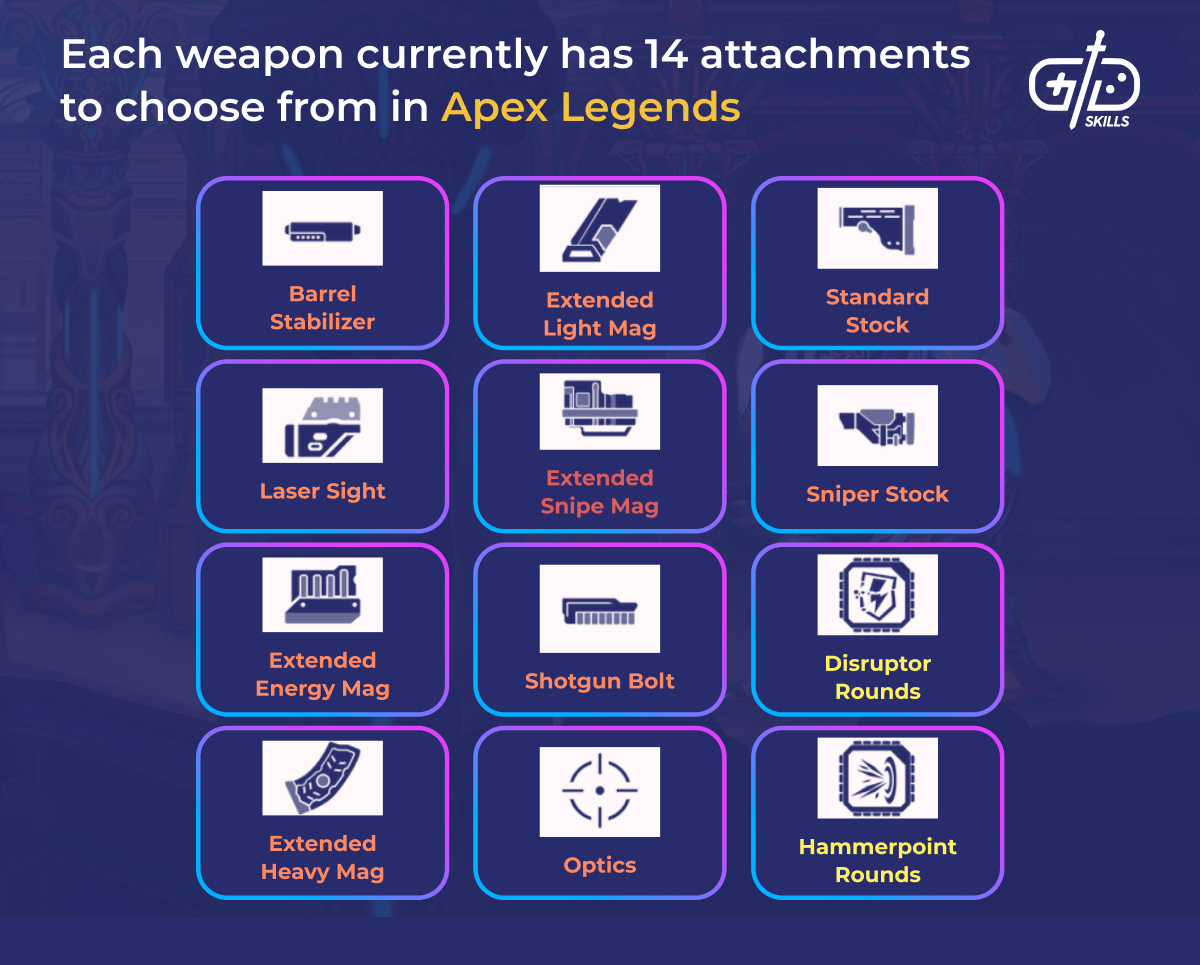
Remember the core principles of balance when responding to playtest feedback. If a player says they don’t like something, it means the game they’re playing doesn’t match the game in their head. A designer’s job is also to ask if the game they’re playing in their head is the same thing as the game in production.
Capture player feedback exactly, so it is possible to respond to the root of the problem. A player says matches feel too long: perhaps giving a timer for each round solves the problem without any changes to match length. Another player says a gun feels weak: maybe the weapon only needs a beefed up sound effect or better visual feedback on hit. Blood, staggers, and hit markers add to gun feel without tuning values.
Consider feedback carefully. The steps to working through issues with balance are laid out below.
- Triage outliers quickly with intuition
- Address root structural issues systematically
- Collect massive amounts of statistical data from players
- Trust in experience and gut feel to identify a true problem
- Test
- Listen
- Iterate
There is a reason why designer and the playtester are different roles. The problem and solution are in some cases unpredictably far away. Griesemer from Bungie says that, for whatever reason, players think the game’s AI is dumb when his maps aren’t lightmapped. The level’s appearance, as unintuitive as it seems, is related to game systems in a player’s mind.
Balancing doesn’t end when the game ships. Balance means knowing how to bring a player closer to a more challenging or more easy experience at different points. Tweak the game over the course of its life to ensure different weapons and playstyles change as time passes. The goal isn’t to keep players perfectly in the flow channel but strategically nudge them in and out to create variety.
What mechanics are used in battle royale game design?
The mechanics used in battle royale game design are a combination of PvP shooter combat and survival game mechanics. Skillful gunplay and strategic use of resources is encouraged. The latter is reinforced through looting and building. Players also engage with the game through its meta. Progression systems, randomization, and cosmetics drive players to replay the game.
Player movement is the same as other shooters. Apex Legends borrows slides and dashes from the Titanfall franchise. Fortnite: Save the World acted as the base for Battle Royale’s combat. Player movement is generally swift so players cross large maps effectively. Battle royales add further aids to movement when the map calls for it. Fortnite has iterated on the grapple gun to allow players to traverse dense areas quickly. PUBG has vehicles to give the player additional movement options.
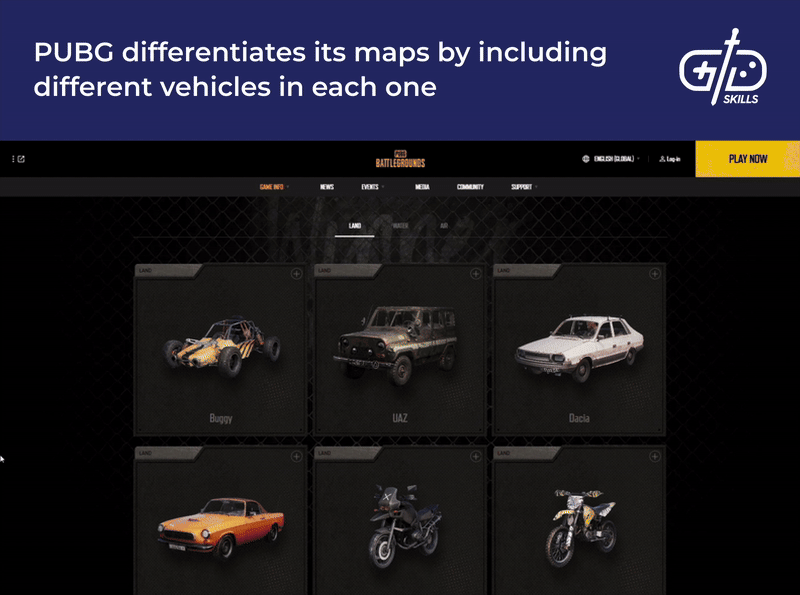
The core combat mechanics give battle royales a high skill ceiling because they are predictable. Maps remain static over the course of a season, so the best places to loot, defend, or escape are learnable. Apex Legends leans into skillful play by giving players a choice of Legend before the match. Players have the chance to become competent in the specific play styles offered by Legends’ abilities.
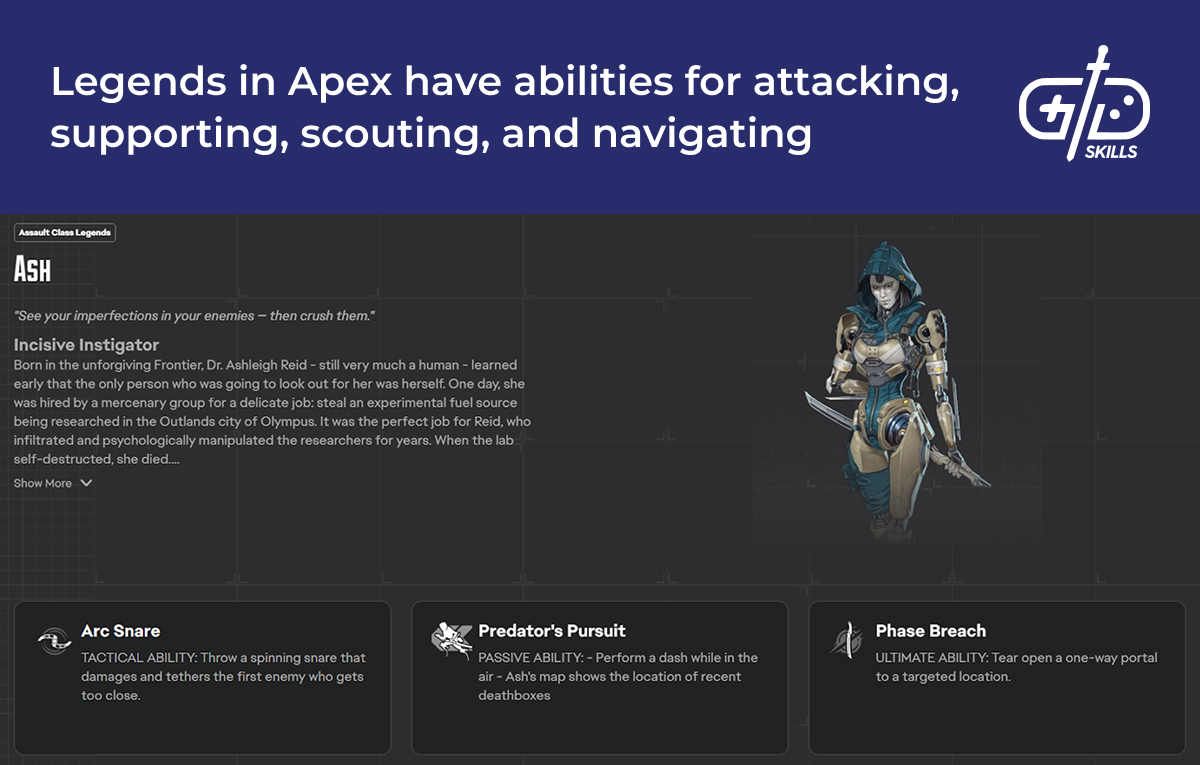
The game systems make for a low skill floor. The randomness of the loot and chaotic scenarios resulting from random starts creates asymmetry. Asymmetry means not every player has the exact same resources, choices, and counters. Rock, paper, scissors is the opposite, an example of a perfectly symmetrical game. Every move is equally effective and victory is strictly random. Battle royale games have a low skill floor because they are asymmetrical: high and low quality gear is available to all.
Looting creates the interactions essential to a battle royale fantasy. Looting is quick and easy, since it is such a dangerous task. Players need a well-tuned UI to manage their inventory in an active multiplayer match. Items often auto-equip if they are a better rarity to keep players in the game. Weapons swap out of a dedicated weapon slot instead of disappearing into a general inventory, so the player spends minimal time playing inventory Jenga. When menuing is necessary, the interface is partially transparent and off the center so skilled players are able to menu in combat.
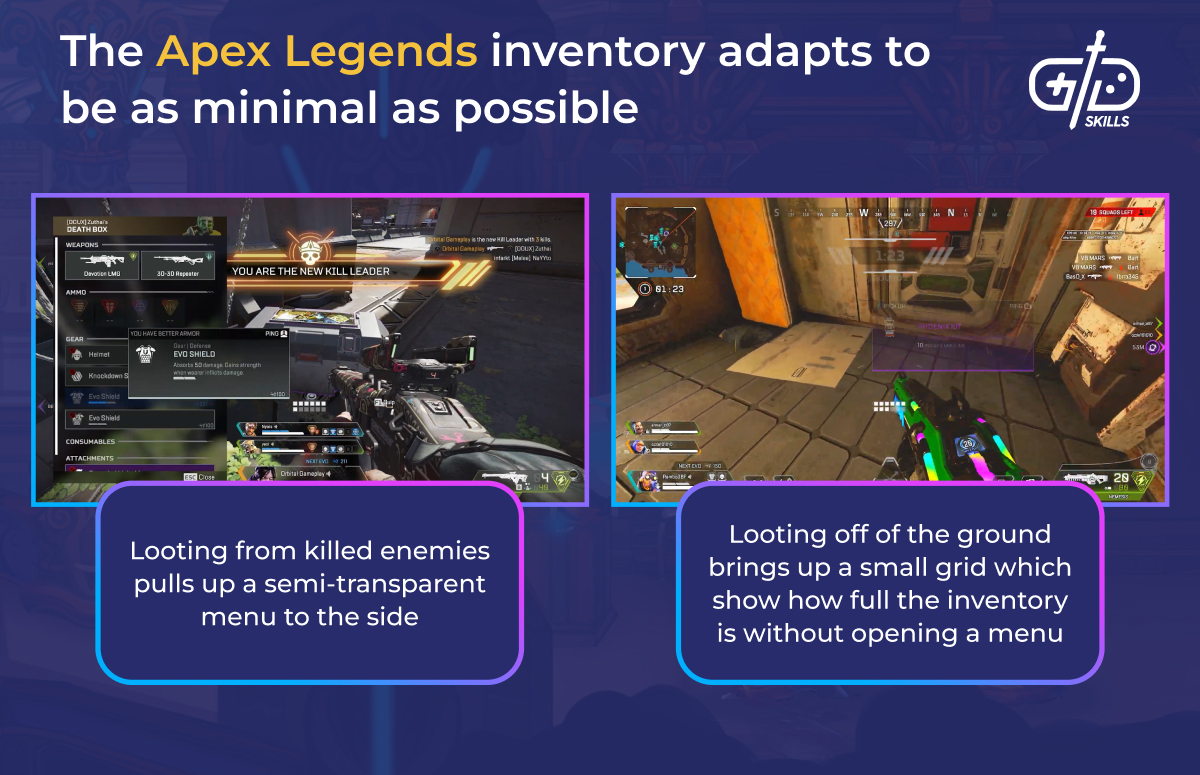
Players in battle royale games are able to affect the level environment like in the survival games that first inspired the genre. Games such as Minecraft, The Forest, and Rust inspire the ability to build or destroy structures in the match. Fortnite players turn materials they find into completely configurable structures. Teams lay down floors, walls and ceilings that enemy players are able to knock down, shoot out, and explode in turn. Players in PUBG don’t build but destroy buildings with missiles, grenades, and vehicles, adding more unpredictability to the ways players approach the level.
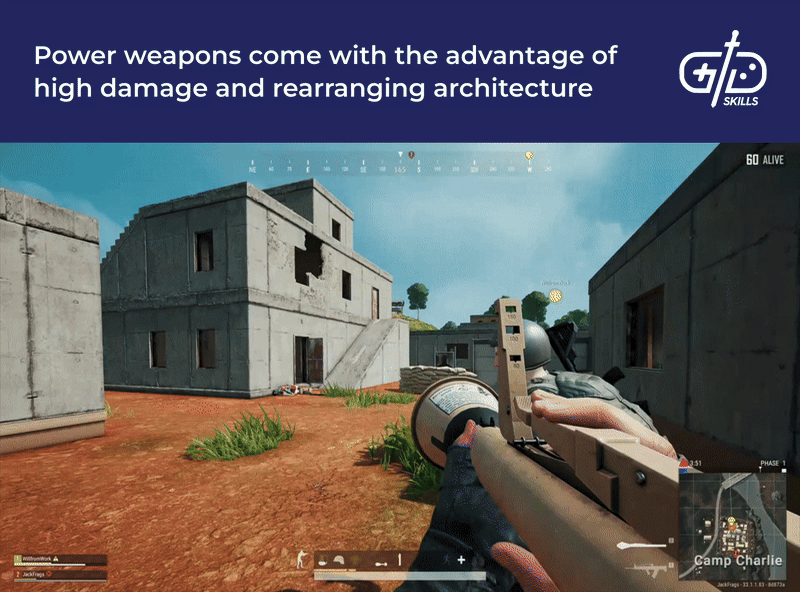
All battle royale games have a progression system outside of the match where players level up their rank in a battle pass. Eliminating enemies, completing challenges, and looting offer the player in-game currency. Players earn larger sums of currency by purchasing it in the store. COD points in Warzone are used to buy items at loadout stations. Apex coins in Apex Legends allow players to purchase new characters. V-Bucks in Fortnite are traded for cosmetics.
Battle royales have a separate progression system for competitive play. Ranked mode works the same across shooters. Player rank goes up by surviving longer, killing enemies, and killing enemies of a higher rank. Rank goes down by doing the opposite: dying earlier, getting killed, and getting killed by lower ranked players. Not playing for a few days or few weeks also lowers rank.
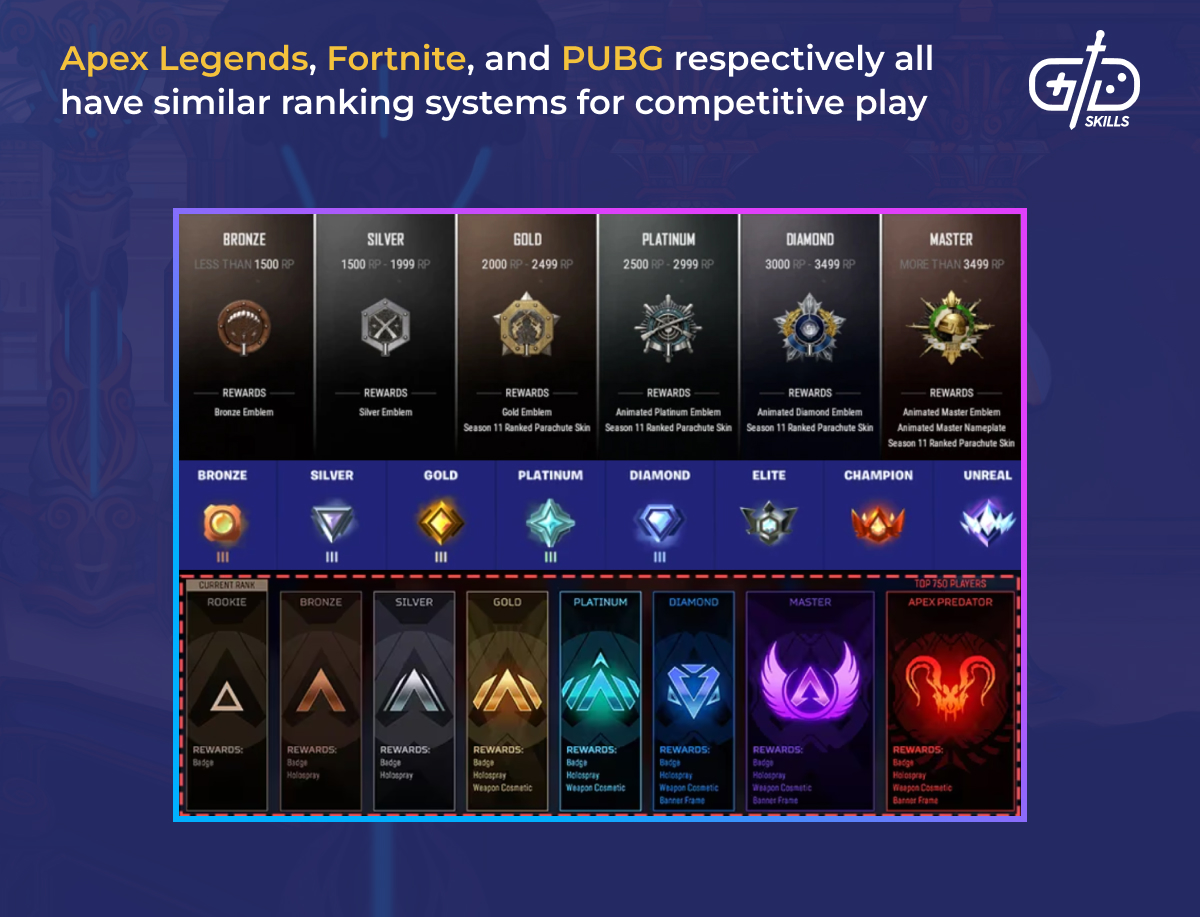
Battle passes encourage players to stay dedicated to the game. The battle pass gives rewards of cosmetics as they gain XP, which is acquired by completing challenges. Seasons only last about a month and a half. A well-tuned battle pass ensures the average player can max it out, but only close to the end of the season. Most games with battle passes limit the rewards earnable in a week so players don’t grind week 1 to max level and then set the game aside.
The battle pass differs from a subscription because player progression through the levels drives the rewards, not cash alone. Battle passes have a free tier for those unable to pay for the extra rewards. Players who do pay get more substantial rewards each time they level up, and the price paid for these rewards is lower than they would have paid for similar rewards in-store. Players feel like they have earned cosmetics through mastery of the game, not just in-game purchases.
Where to find a battle royale game design template?
Find a battle royale game design template in asset stores online. New designers have options from Epic Games for editing Fortnite directly, which is a good place to start for people testing what works in the genre. Unity has extensive templates as well that allow a designer to tweak and add from there. Design isn’t as simple as filling in a barebones template, however. The most important part to make a successful commercial product is to add a twist that hooks the player.
Epic Games is the creator of the Unreal Engine and Fortnite, so Fortnite Battle Royale supports importing maps directly from the Unreal Editor for Fortnite (UEFN). Epic Games’ site has tutorials and sample projects for getting started. Unreal has terrain shaping and painting tools in-engine. Fortnite Creative enables the designer to add loot, buildings, and art assets in-game. UEFN has Verse, a programming language for adding and making a level respond to events at runtime.
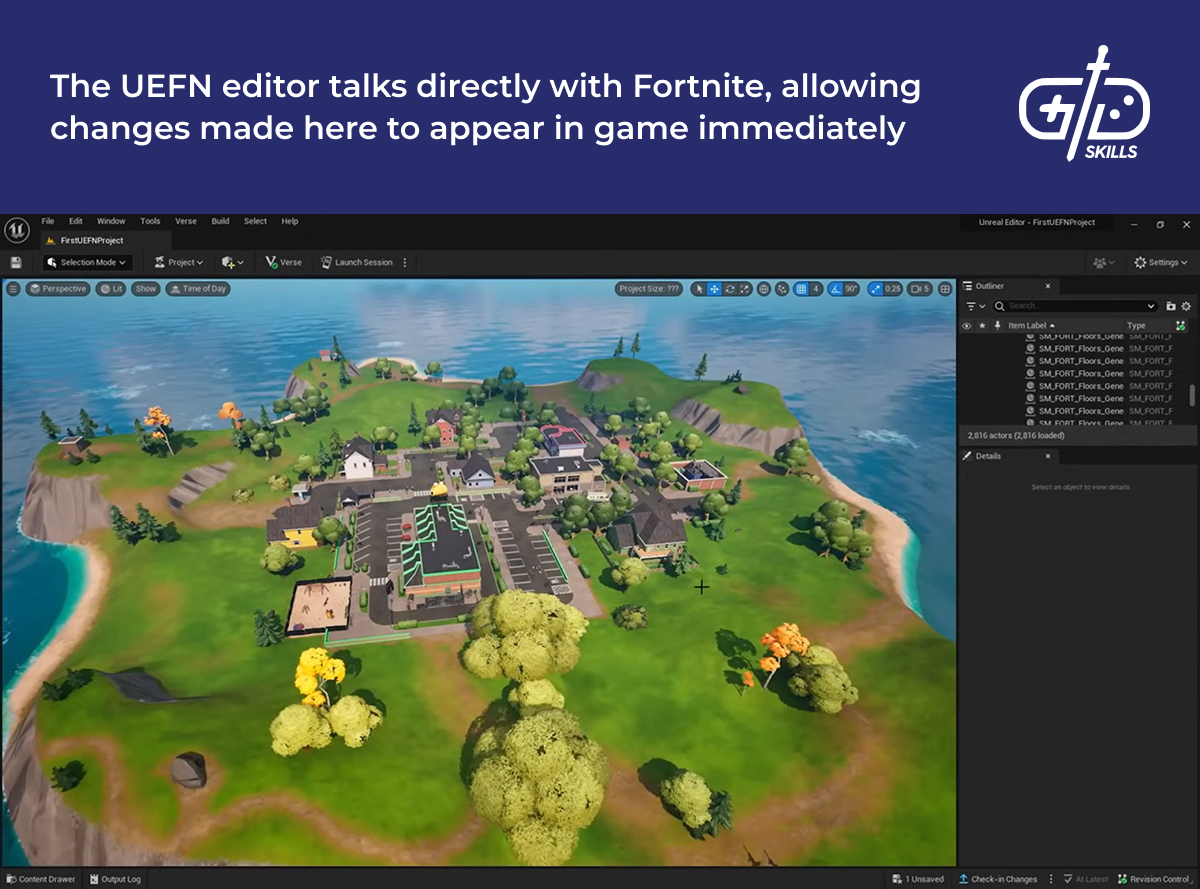
Unity is another popular game engine with tools for creating battle royale games. The “battle royale” tag in the Unity asset store brings up levels and pre-built mechanics which are suitable for building a new game or fleshing out a map. The BR200 pack has a basic blockout, but also comes with character controllers and multiplayer-synced animations. Assets such as vehicles, characters, UI, and weapons packs are available on the Unity store as well for integration into an existing framework.
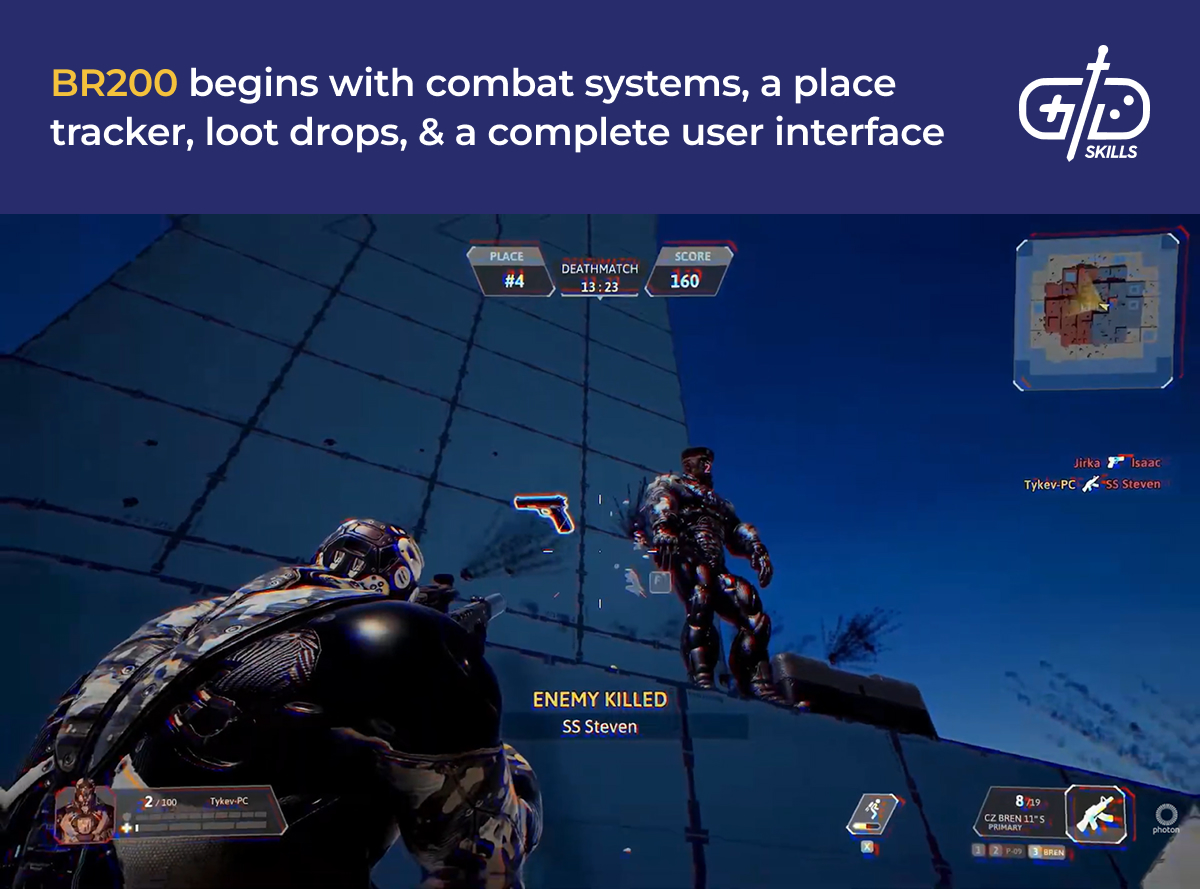
Beginning with a template isn’t enough to create a game that stands out in this market. Each of the big battle royale games have a unique mechanic or theme. Fortnite has building, and Apex Legends has the character selection system. PUBG is a more pure realization of the genre, especially since it is the game that made battle royale popular, but still stands out with its realistic aesthetic.
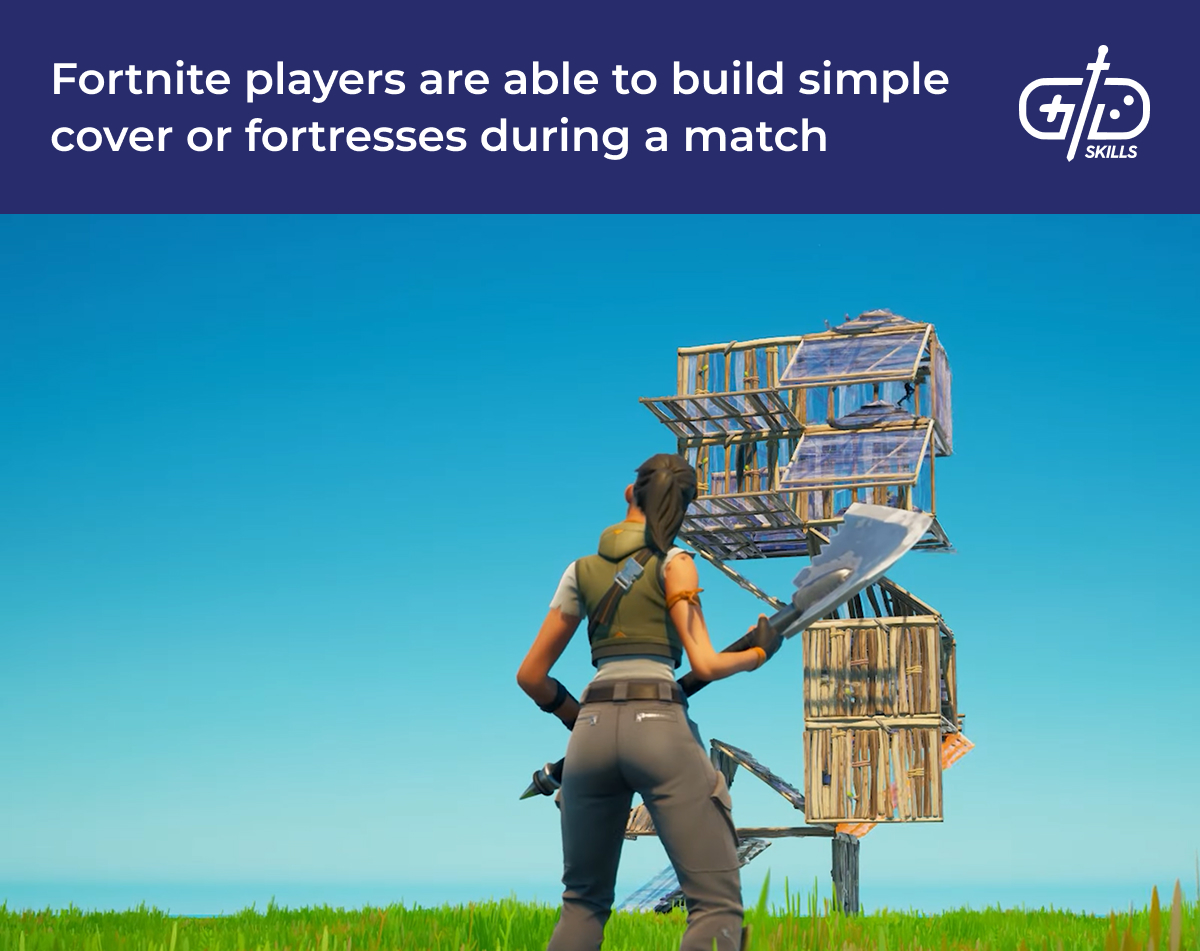
The only core to a battle royale game is the concept of a free-for-all fight to the death. Recent battle royale games lean into their own strengths or change the format entirely by bringing battle royale to new genres. Totally Accurate Battlegrounds is a parody of PUBG. The art is stylized and ragdoll physics excessive. The fun comes from making your friends’ bodies fly around with the numerous explosives and melee weapons. Dusty Derby is an indie example where players control balls of dust rolling around a household. This game has players compete in minigames until one winner is left.
What is an example of a battle royale game design document?
No example of a battle royale game design document has been published. The features are mostly set in stone for each iteration of the formula: large maps, large matches, weapons, vehicles, random loot generation, battle pass progression systems, and in-game purchases of cosmetics. Use a general template for a game design document and add to that as development continues. Insights into development principles come from ad hoc information put out into the community.
Epic Games has extensive documentation on Fortnite, since community maps are such a large part of the experience. The documentation is far more detailed than is necessary for a game design document, but their tutorials give an idea of the kinds of features possible with the game. There are also developers from Epic Games with a presence online who show what goes into designing their games.

Designers from the biggest battle royale games have talked numerous times to the media about their process. David Vonderhaar from Treyarch did several interviews during his time working on Warzone, and Brendan Greene of PUBG has gone to events all over the world. Brendan Greene has made appearances discussing his game at the VIEW conference, Game Developer’s Conference, and the GamesBeat summit.
Please tell us in the comments about what you’ve learned. Do you have any experience designing levels for battle royale games? Do you know of any other designers who have shared their knowledge about battle royale design? We welcome any feedback on the article below.


